The Silk Road is a series of trade and cultural transmission routes that were central to cultural interaction through regions of the Asian continent connecting the West and East by linking traders, merchants, pilgrims, monks, soldiers, nomads, and urban dwellers from China and India to the Mediterranean Sea during various periods of time. Silk, the most luxurious fabric of all, was almost exclusively made in China until the secret was revealed in the 7th century to the West. This precious commodity attracted Central Asian merchants, who in exchange brought horses, cattle, furs, hides, and luxuries, such as ivory and jade, to China.
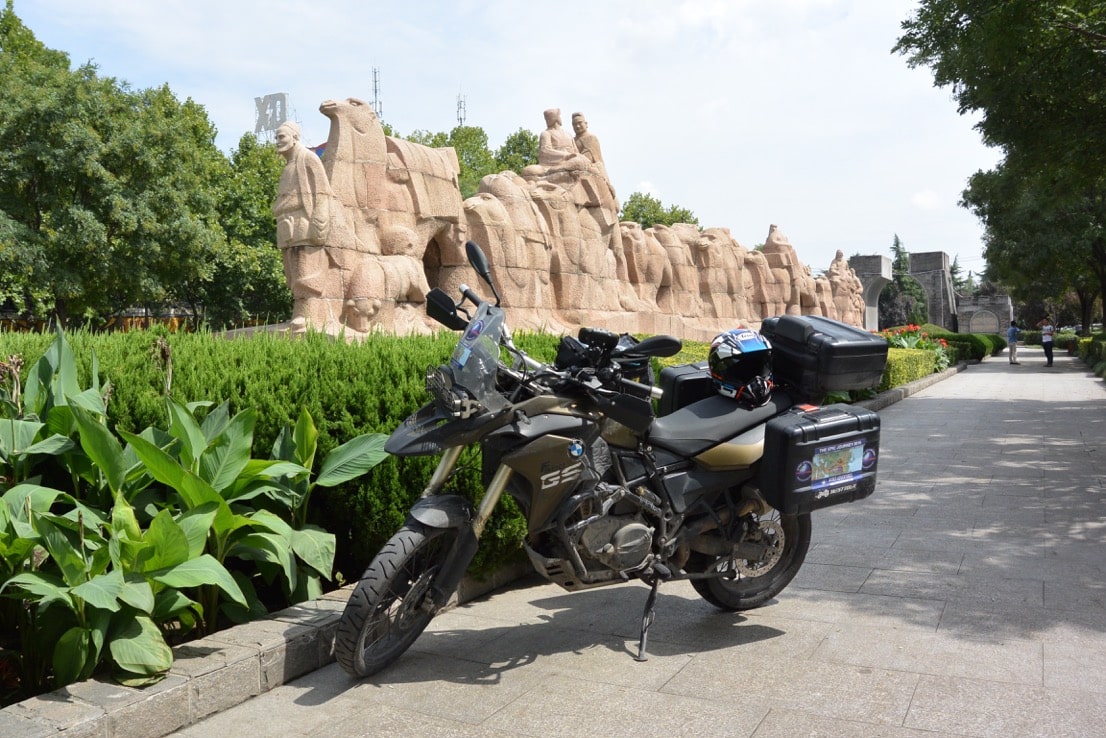
Pingliang – Lanzhou – Youngchang
At the start of the Silk road in Xian. Next we shall ride the Road to the far west of China. (by David Fick)
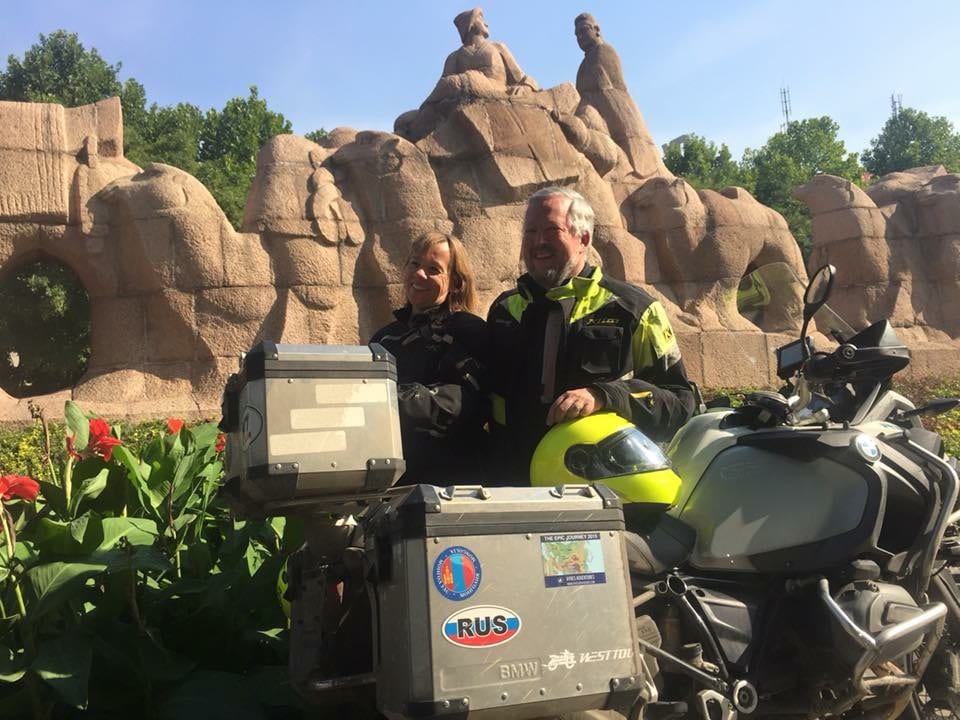
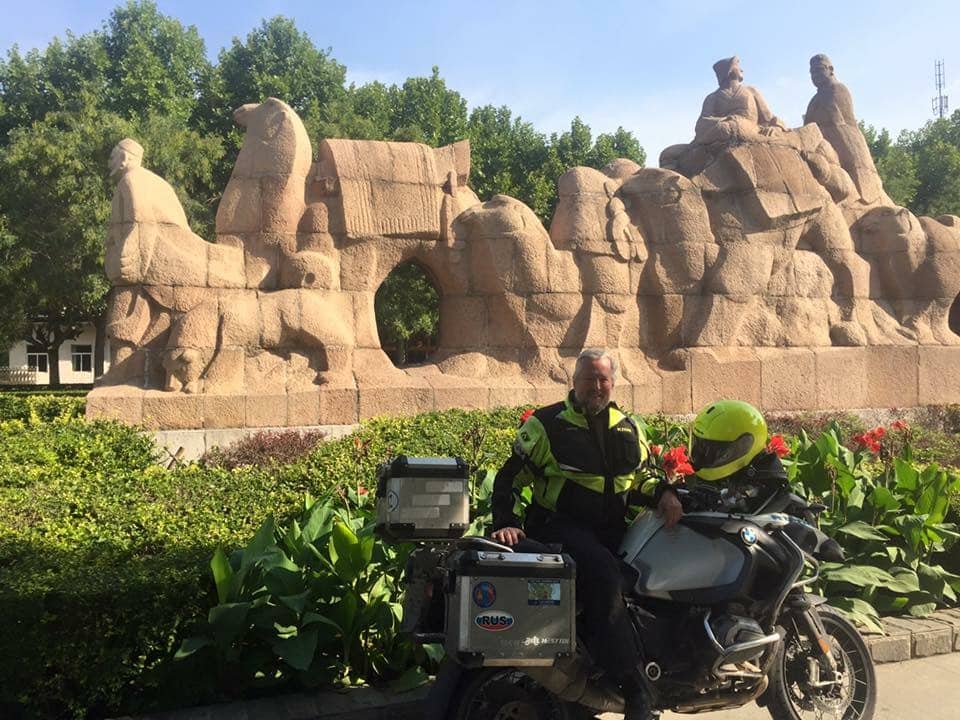
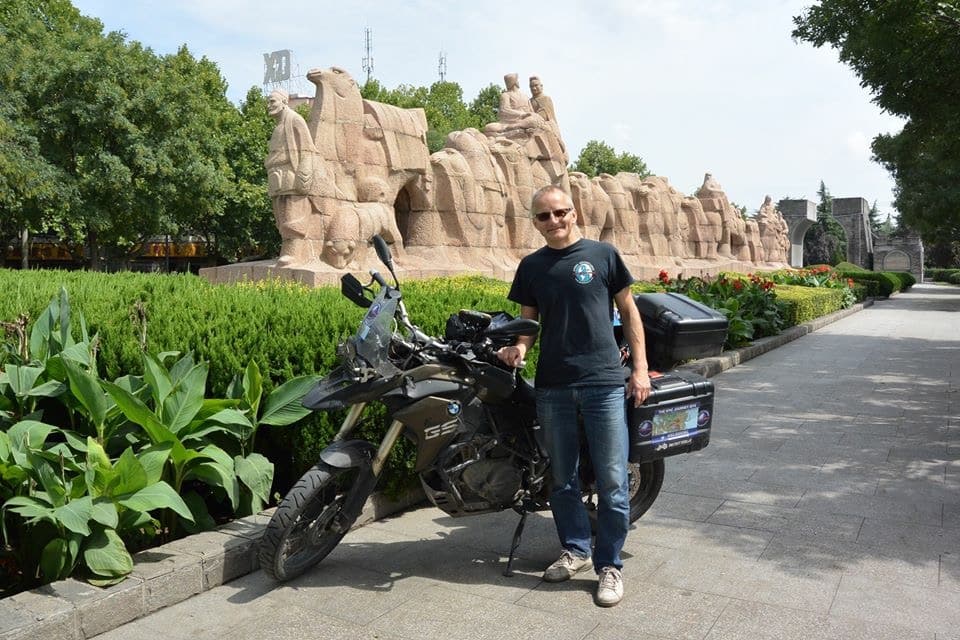 We are in Piangliang, China, about 240 miles northwest from Xian. This is not the most direct route to Hong Kong, but it is designed to take us through a beautiful and unknown part of China. Our tour guides scouted the route last year and we are totally off the beaten track. For the first time, I am truly glad that we are NOT on the expressway.
We are in Piangliang, China, about 240 miles northwest from Xian. This is not the most direct route to Hong Kong, but it is designed to take us through a beautiful and unknown part of China. Our tour guides scouted the route last year and we are totally off the beaten track. For the first time, I am truly glad that we are NOT on the expressway.
Leaving Xian was a mess. It took a couple of hours to get out of town. But like riding north from L.A., you eventually hit Santa Barbara County or the wine country, and we hit the jackpot. This was my favorite riding day of the trip. We rose to about 5000 feet and were in the mountain farmlands. Blue sky, clean, dry air, and temps in the 70’s. Switchbacks, twisties and ups and downs. Much like the Texas Hill Country or the twisties around Los Alamos, N.M. The kind of conditions that motorcycle riders live for.
On the way we discovered some hand carved house caves (yaodongs) used by farmers with fields in the area. The caves stay cool in the summer and warm in winter. There were hundreds of them. An estimated forty million people in northern China live in these house caves! One old woman chose to live in her cave even though her family lived in the city. (by Randy McClanahan)
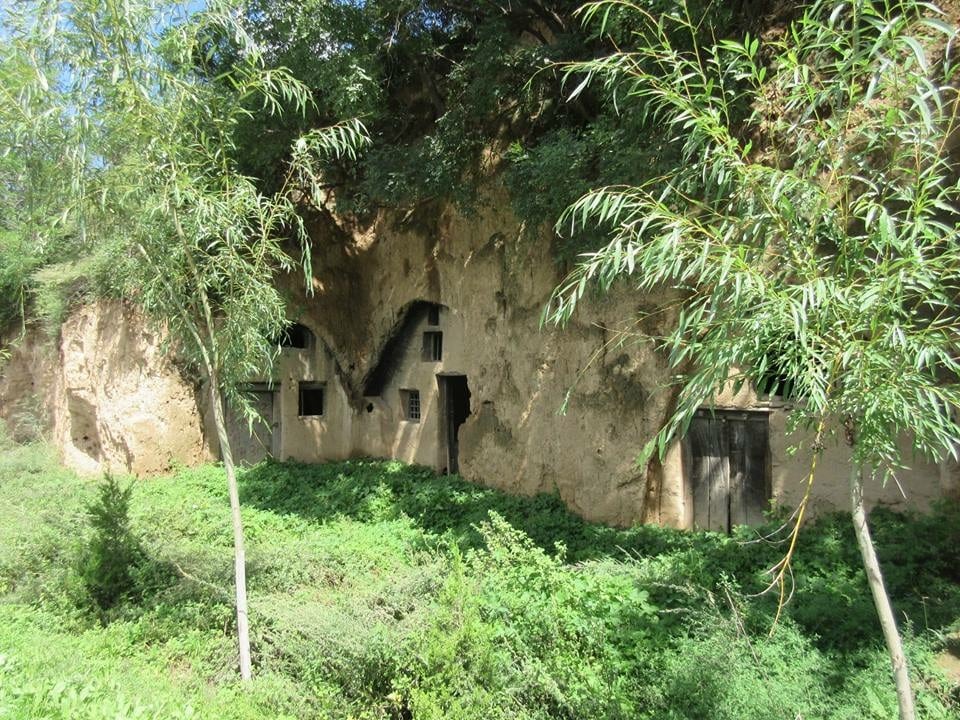 The farmland is terraced. Instead of a wasted hillside, imagine that hundreds of years ago the farmers chiseled terraces down the mountainside so that dozens of narrow fields would be available for family farms. Now visualize 30 terraces down a mountainside. Now multiply that by hundreds of mountainsides as far as the eye can see. Each terrace is meticulously tended by hand.
The farmland is terraced. Instead of a wasted hillside, imagine that hundreds of years ago the farmers chiseled terraces down the mountainside so that dozens of narrow fields would be available for family farms. Now visualize 30 terraces down a mountainside. Now multiply that by hundreds of mountainsides as far as the eye can see. Each terrace is meticulously tended by hand.
This appears to be a corn area. It is harvest season. As we ride, we sometimes see ears of corn, and sometimes individual kernels, drying on the road, in driveways and in public places like schoolyards and town squares. Each spread of corn is raked to dry and tended by a human. No machines here. Everything is done by hand! Notice the guy raking at the top of the photo. Just take care not to run over the corn on the road as you ride. (by Randy McClanahan)
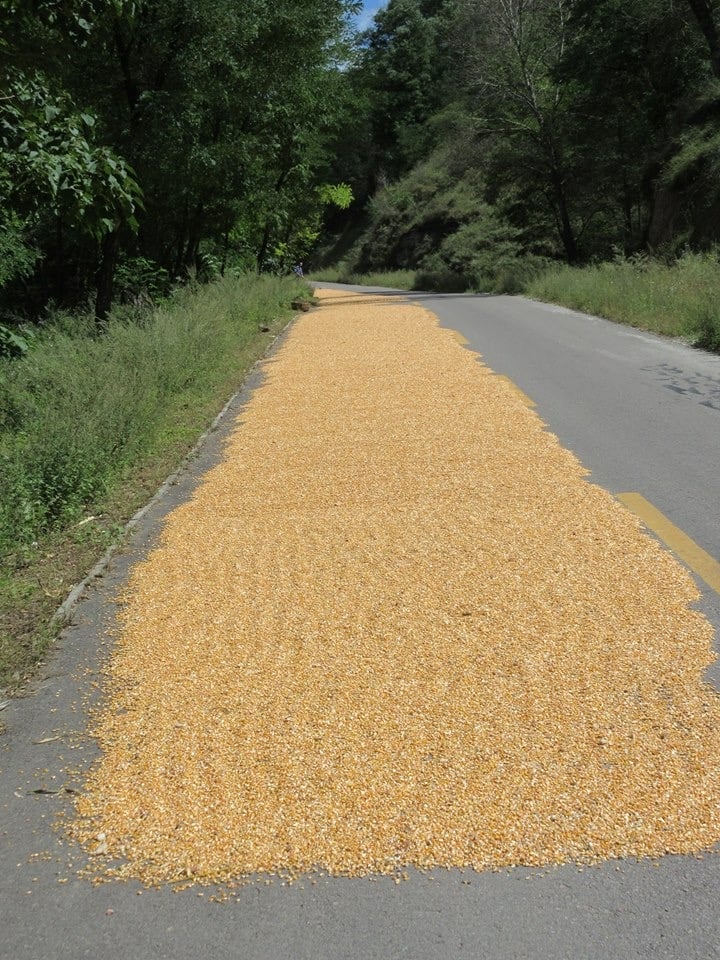 We came up on these abandoned cave dwellings on the side of the road. (by Mike Bozarth)
We came up on these abandoned cave dwellings on the side of the road. (by Mike Bozarth)
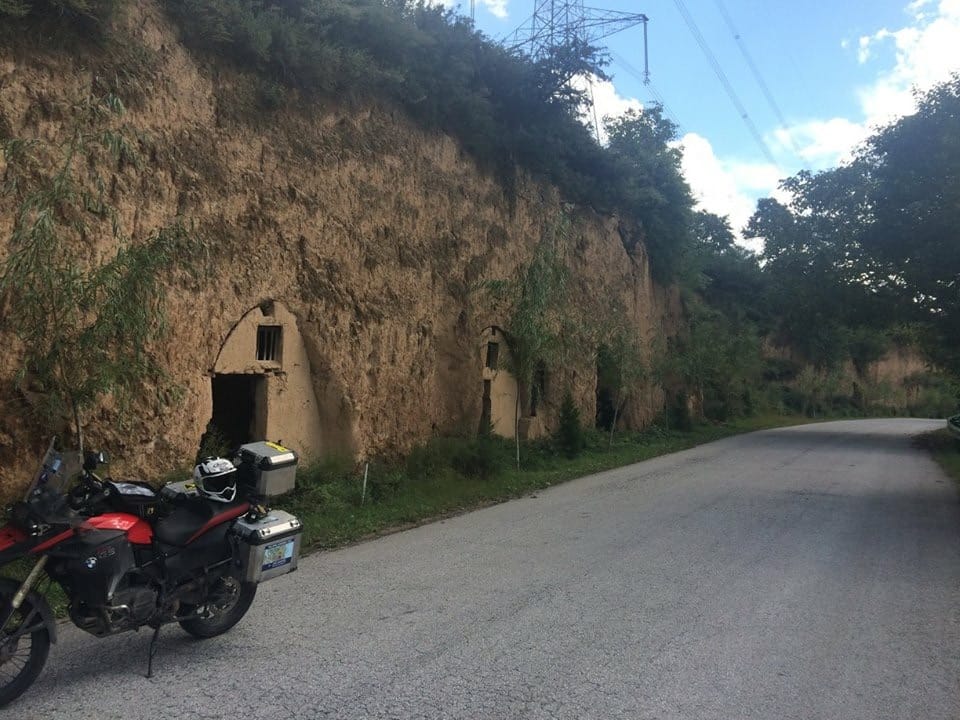 Abandoned cave dwelling (Old school studio apartment, Chinese style) (by Mike Bozarth)
Abandoned cave dwelling (Old school studio apartment, Chinese style) (by Mike Bozarth)
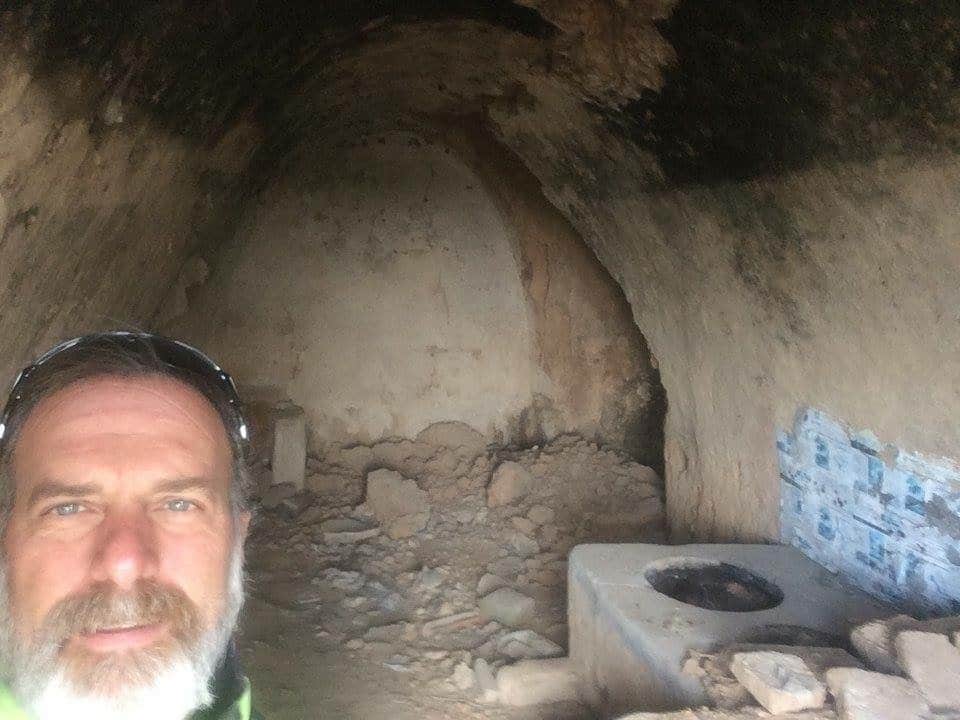
But the best part was the kids. I have read that Maria gave up her long term gig on Sesame Street. I was thinking of applying for the job, but then I met some kids at our lunch stop today. They were timid at first, but we soon evolved to fist pumps, high fives, arm wrestling (they always won), “what is your name?” and “how old are you?” The kids and I became fast friends. I figure that I can start Sesame Street China and play the role of “Big Landy.” It was a very cool experience! My favorite part of China is interacting with people who have never seen an American before! (by Randy McClanahan)
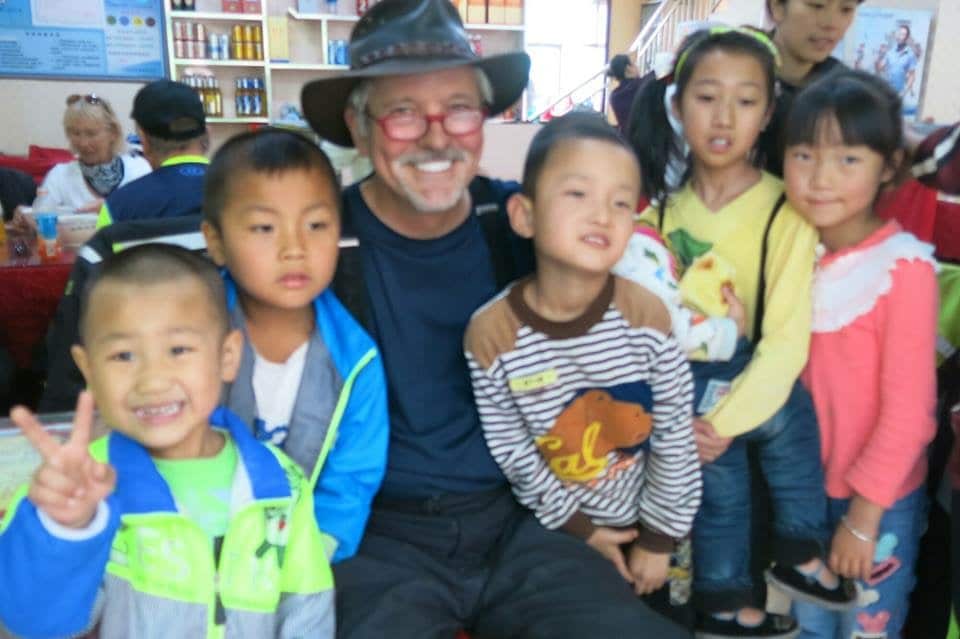 Sunrise over the city of Lanzhou.
Sunrise over the city of Lanzhou.
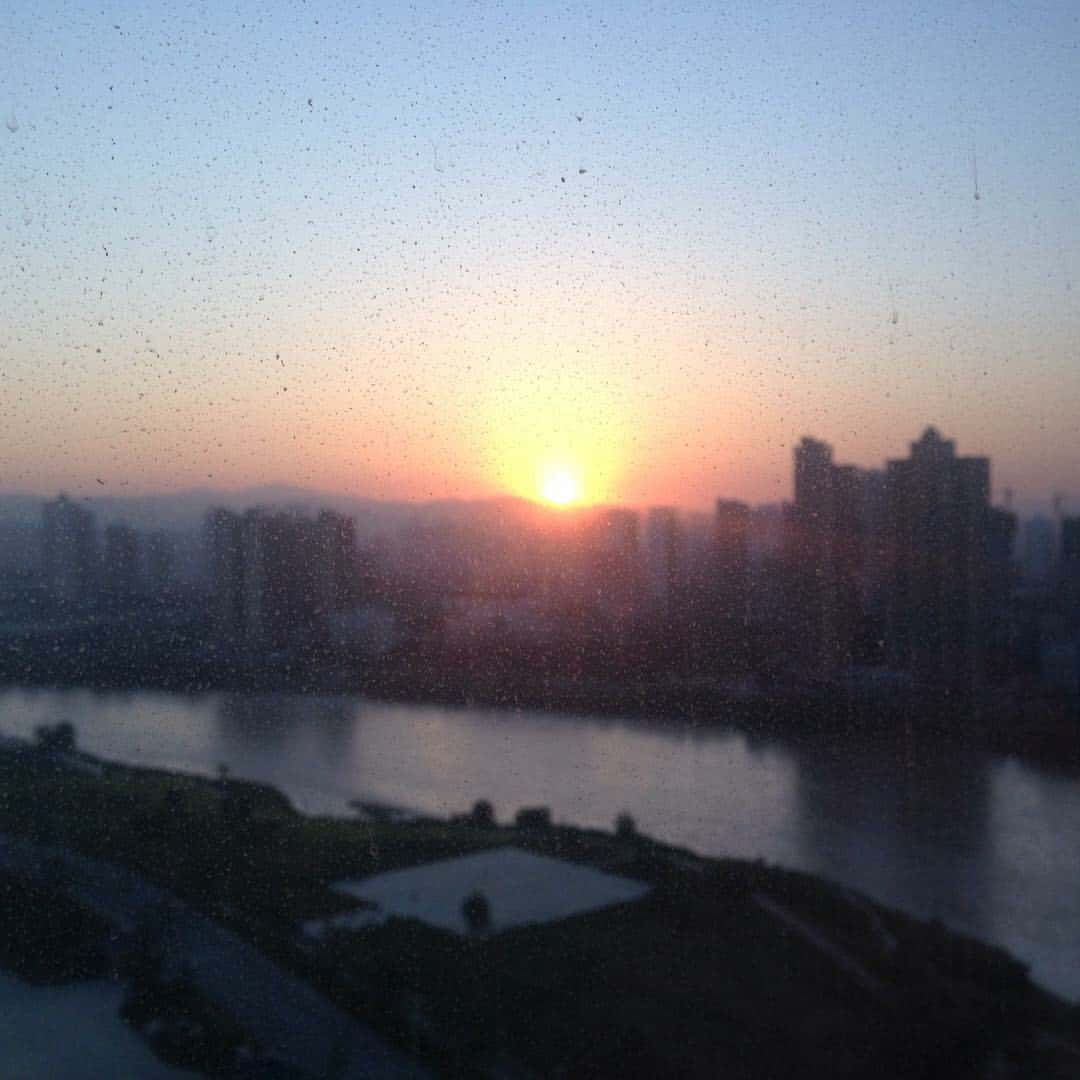 To get to Hong Kong, we need to go southeast. So today we went northwest, in the opposite direction. Since we have come so far, we want to see as much of the “real China” as possible, so we are headed back into the Gobi Desert. Tonight we are in Youngchang, and I don’t mean the piano company. I could not find the town in Google. Forget about any English, anywhere, by anyone. They don’t even understand my iPhone translator in this town. But the people could not possibly be nicer.
To get to Hong Kong, we need to go southeast. So today we went northwest, in the opposite direction. Since we have come so far, we want to see as much of the “real China” as possible, so we are headed back into the Gobi Desert. Tonight we are in Youngchang, and I don’t mean the piano company. I could not find the town in Google. Forget about any English, anywhere, by anyone. They don’t even understand my iPhone translator in this town. But the people could not possibly be nicer.
Remember the Queen song in today’s title? Well, we lost another rider today. Chinese drivers turn right without looking. They assume you see them and that you will take evasive action. Today we left Lanzhou. The roads are quite dirty, so the Chinese have water trucks everywhere, spraying water from the top and bottom of the truck. This is very bad for motorcycles, as it makes the grimy roads even more slippery. The amusing thing is that they play a warning song so people will know they are coming. It is the same song everywhere we have been. What is it? Are you ready for this? The song they universally play everywhere in China is . . . “It’s a Small World (after all).” It sounds just like any ice cream truck in the U.S.! (by Randy McClanahan)
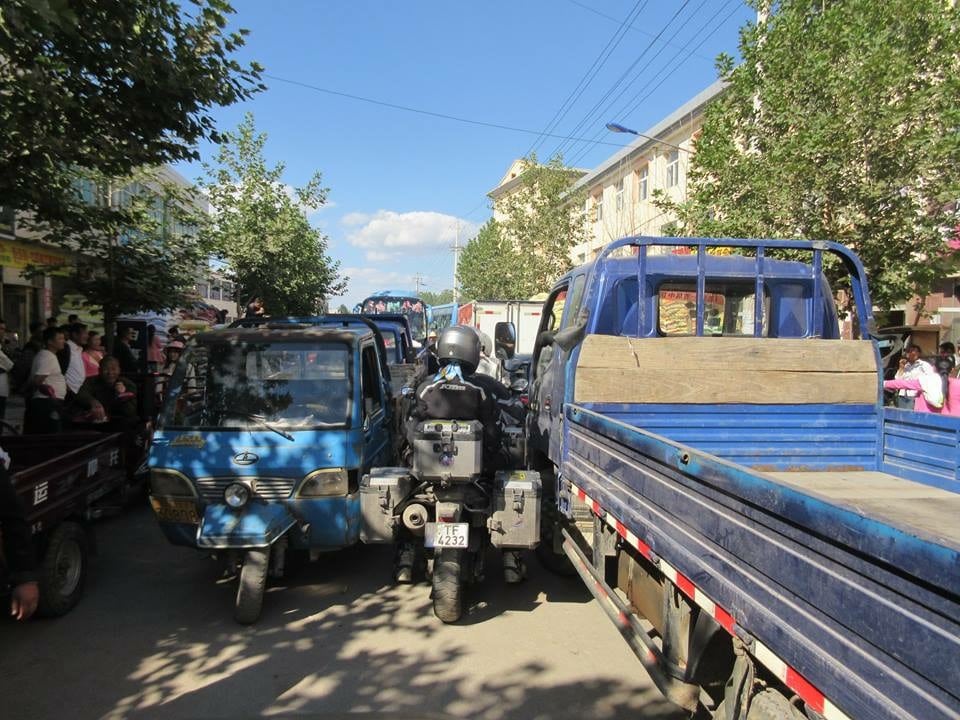
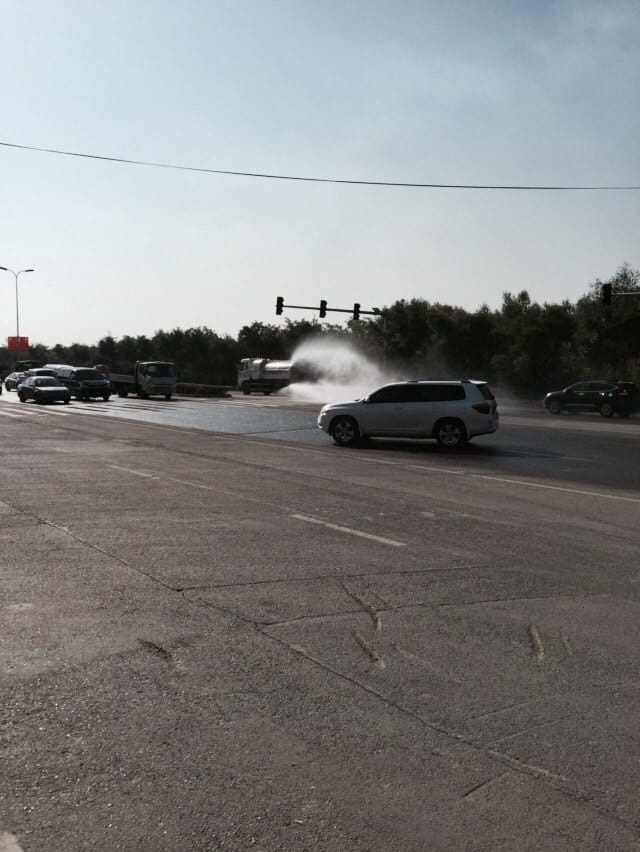 Finally, as we were waiting on a flat tire repair, I glanced up a hill and saw a part of the un-retouched Great Wall of China. We will see it again, but I thought it was cool that I recognized it. A Chinese highway officer confirmed what it was using my smart aleky little translator!
Finally, as we were waiting on a flat tire repair, I glanced up a hill and saw a part of the un-retouched Great Wall of China. We will see it again, but I thought it was cool that I recognized it. A Chinese highway officer confirmed what it was using my smart aleky little translator!
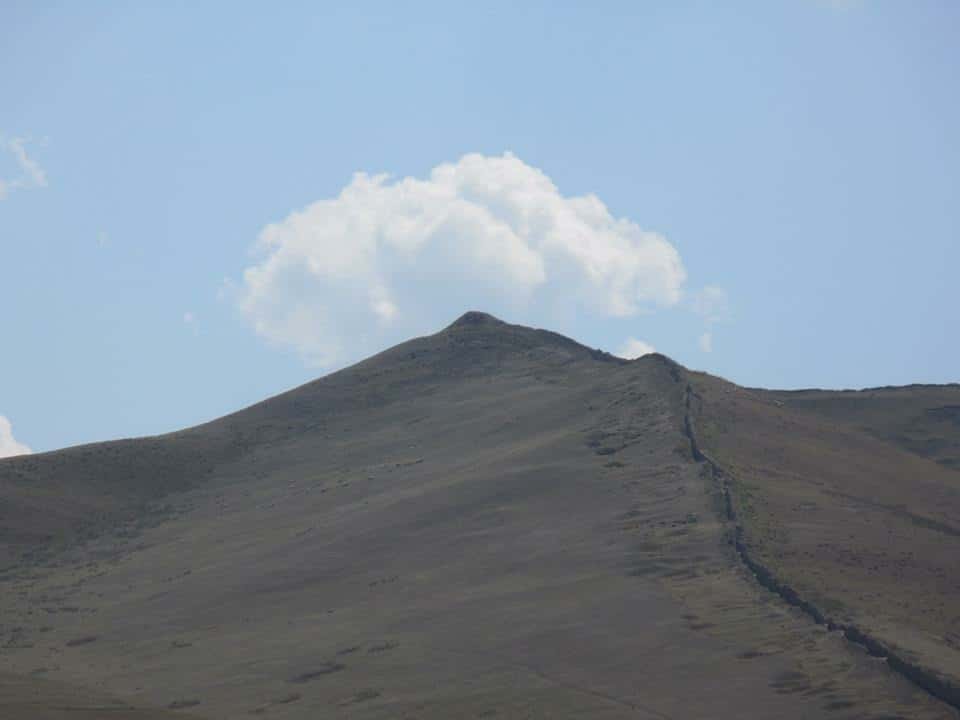 The Great Wall, an old part.
The Great Wall, an old part.Great days riding after a quick climb up an old part of the Great Wall of China to the guard tower in the background!
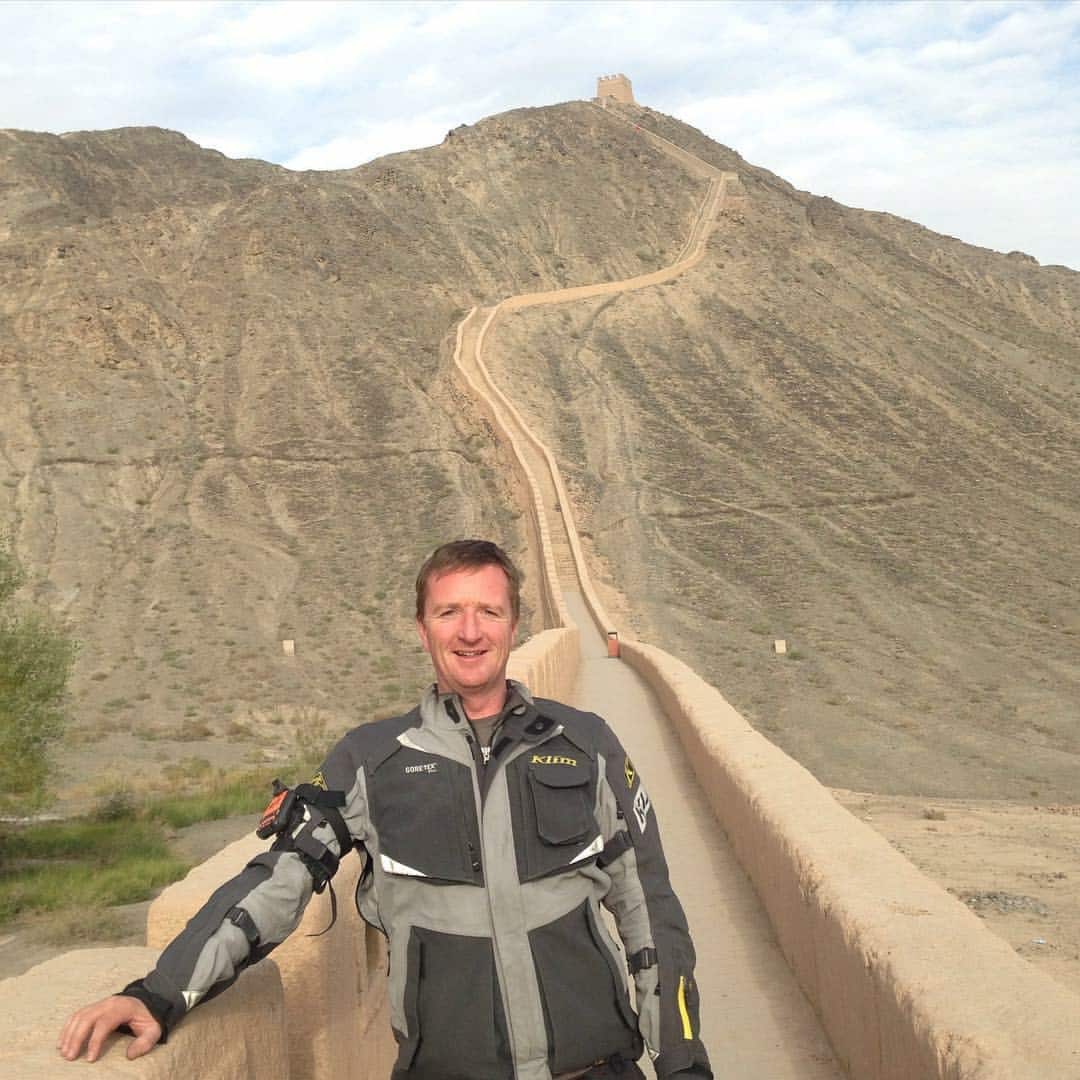 Near the end of the Great Wall. Wonderfull day riding a lot of dirt and gravel, and we climbed to the top of the mountain on the wall in this picture. (by David Fick)
Near the end of the Great Wall. Wonderfull day riding a lot of dirt and gravel, and we climbed to the top of the mountain on the wall in this picture. (by David Fick)
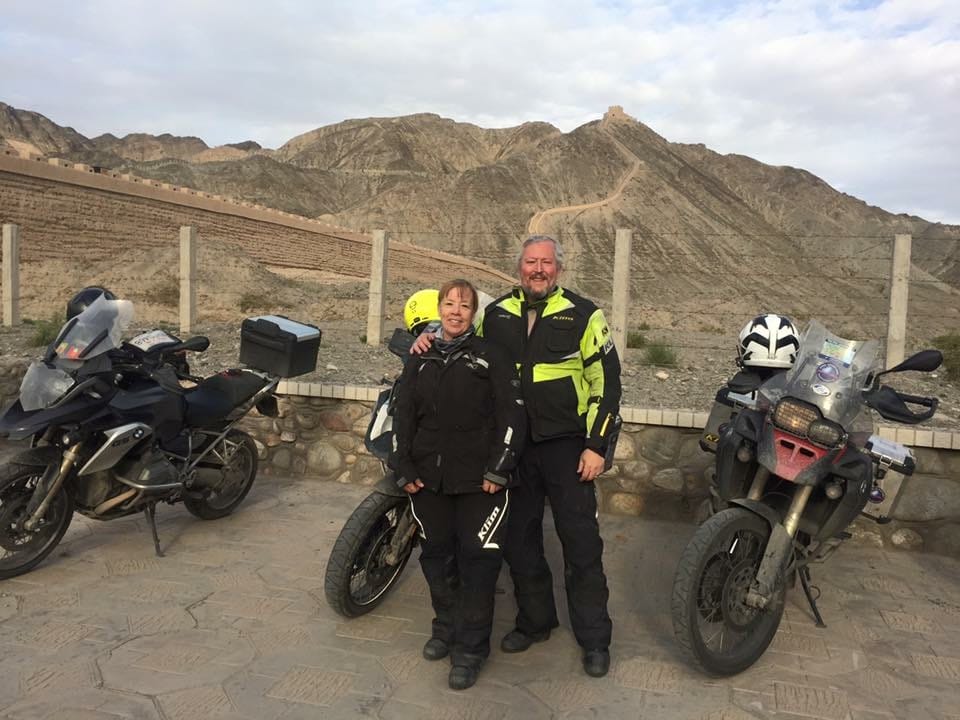 So apparently it’s just a big wall. Guess that’s what makes it great. (by Mike Meyer)
So apparently it’s just a big wall. Guess that’s what makes it great. (by Mike Meyer)
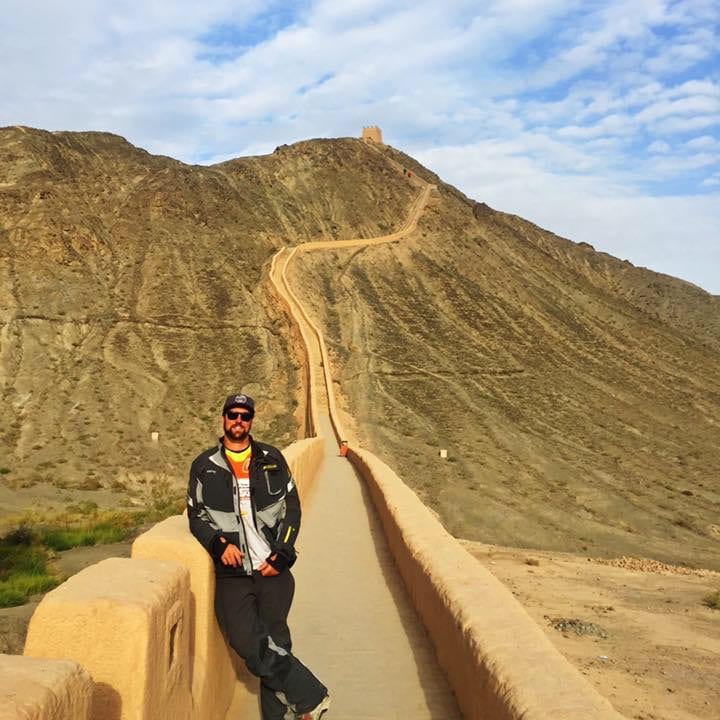
Today we saw, up close, the unretouched Great Wall. Not the same as for the tourists.
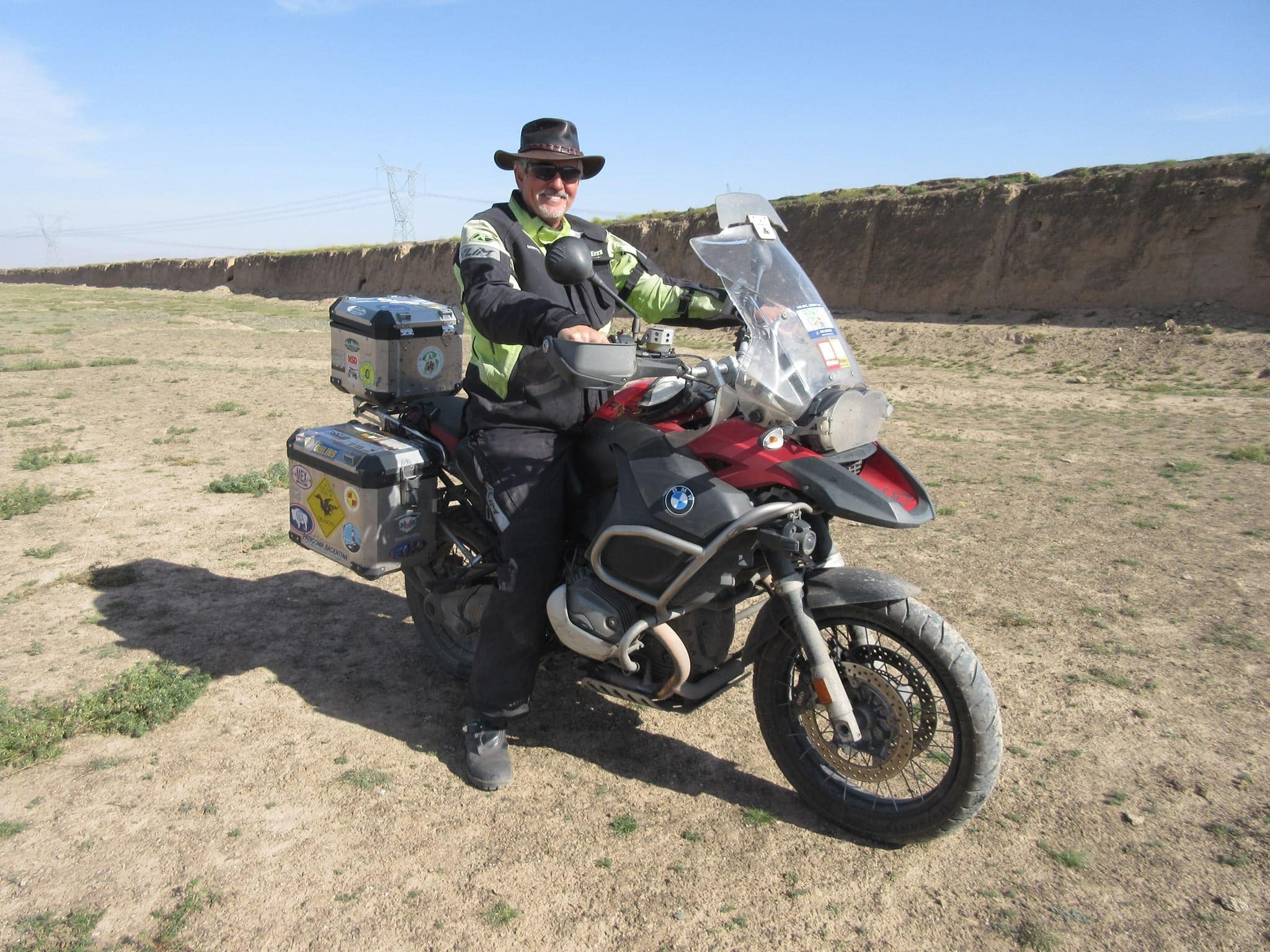
Along the way to Dun Huang
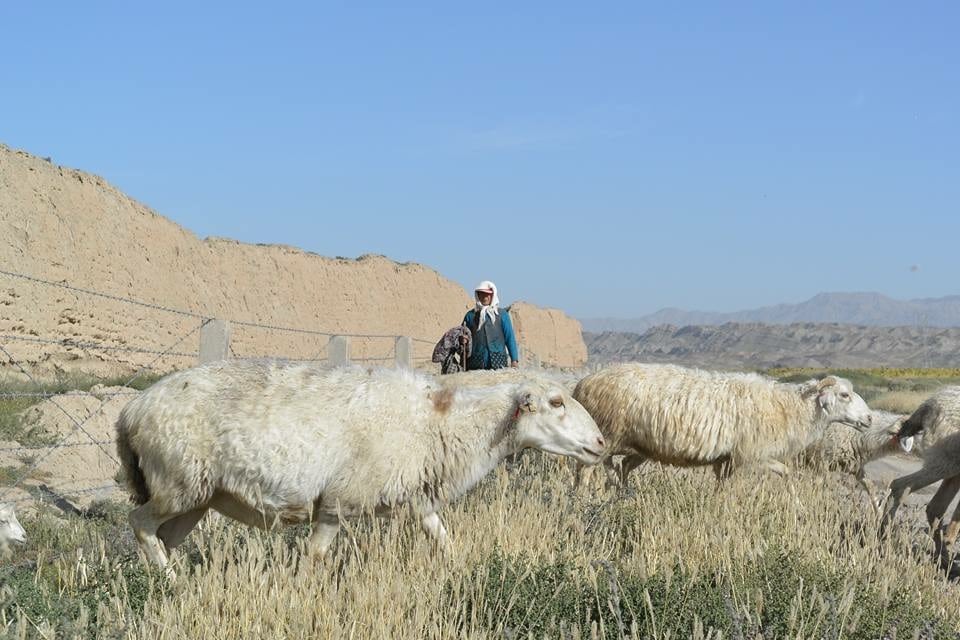
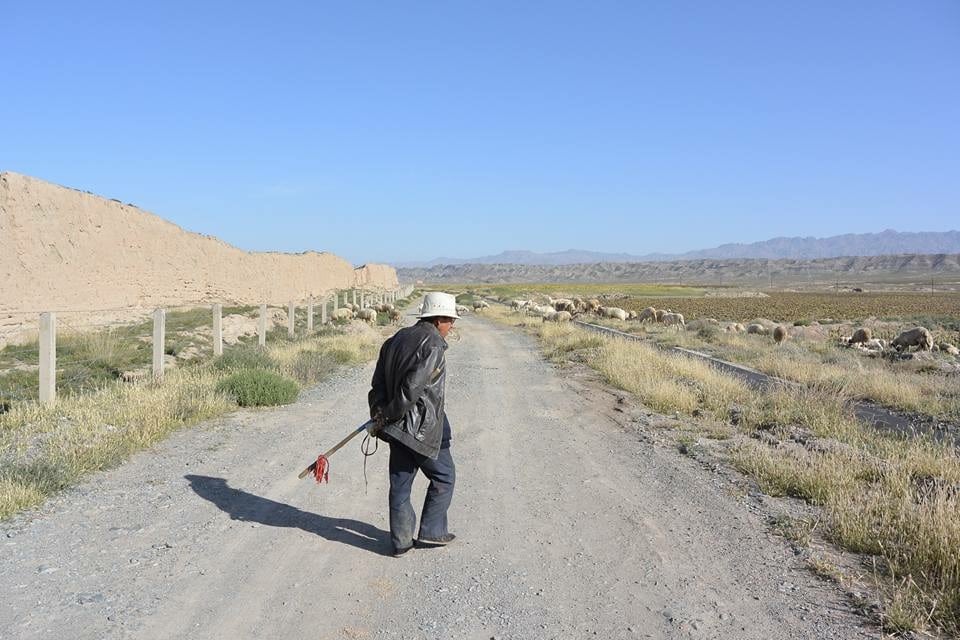
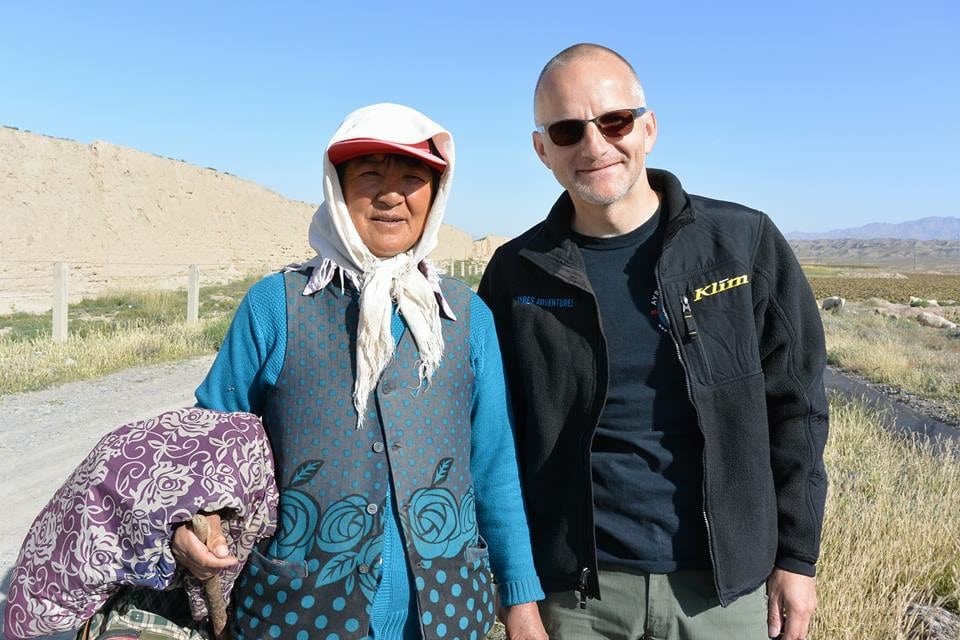 Rest day at the Silk Road Dun Huang Hotel
Rest day at the Silk Road Dun Huang HotelThis is the westernmost point in our swing back through the Gobi, next up is southern China, heading southeast from here. (by David Fick)
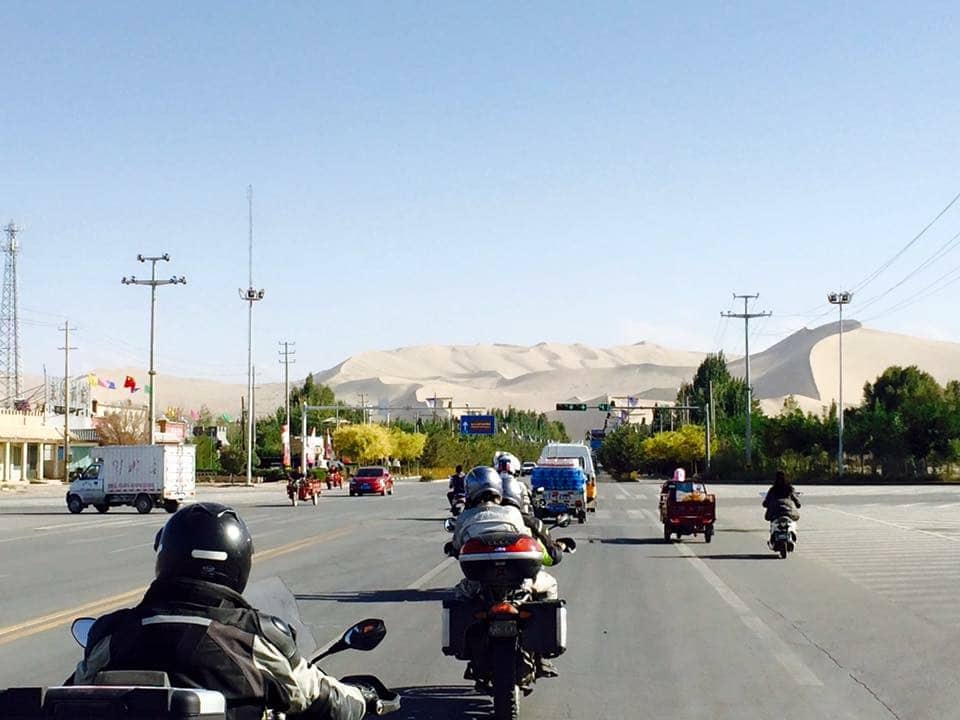
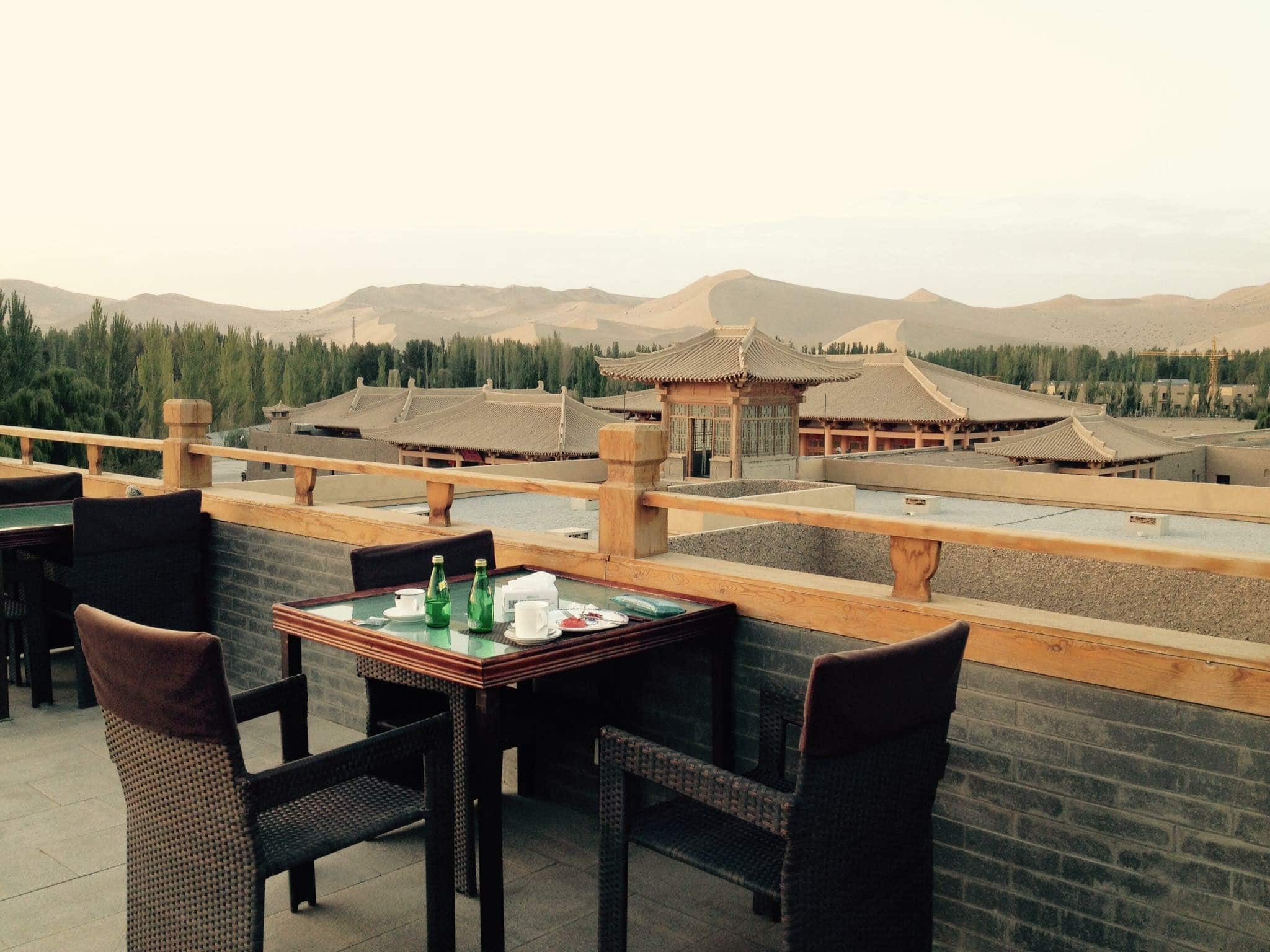 Beautiful sunrise over the Gobi Desert dunes.
Beautiful sunrise over the Gobi Desert dunes.
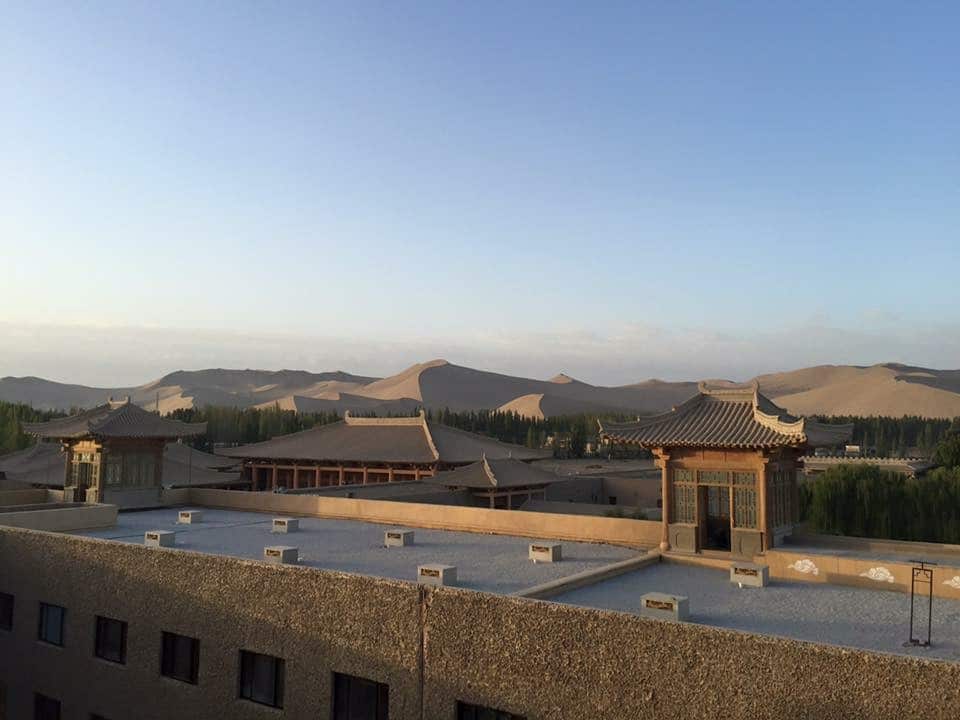
Free day in Dun Huang. Mogao Caves
This place is a UNESCO World Heritage Site, and clearly should be. Several things had to happen for it to come into existence.
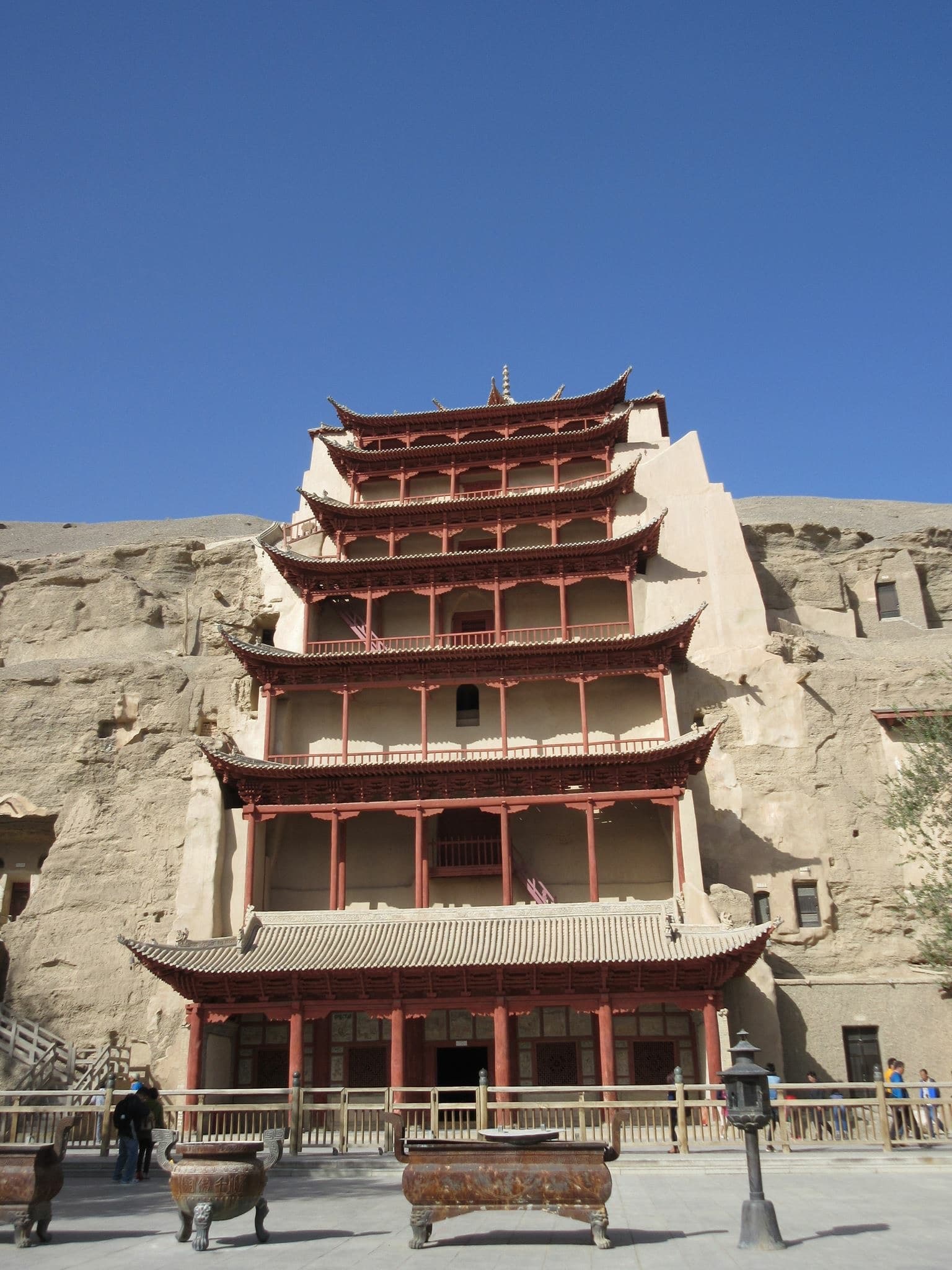
First was the Silk Road, a series of trade routes connecting China, India, Persia and Europe. It was dangerous. There were sandstorms, floods, landslides, and bandits. There were also warring clans who ruthlessly destroyed the camps of people they wanted to keep out of “their” lands. Second is Buddhism, which started in India about 500 BCE and came to China by at least the first century BCE. It came via the Silk Road. Third was the fortuitous location of Dunhuang.
To get into or out of Xi’an, the start (or end) of the Silk Road, you had to pass through a narrow corridor between the impassible Himalayas and the unsurvivable Gobi desert. That narrow corridor took you through Dunhuang, which is where we are now. If you wanted to trade with China, you had to pass through Dunhuang.
A wandering monk saw a magical light shining on a sandstone cliff near here, and determined to build a cave to meditate and contemplate Buddha. He was joined by a second monk, and more and more came. Then the ruling families built worship caves. Then rich merchants, seeking to have good luck on their dangerous Silk Road ventures, hired artists and craftsmen to develop their own caves. Over the next several hundred years there were about 1000 Buddhist worship caves here, and they became quite elaborate. The place is chock full of rock cut architecture, murals, sculpture and paintings. But as the Silk Road declined, the caves fell into disuse, and were swallowed up by the desert.
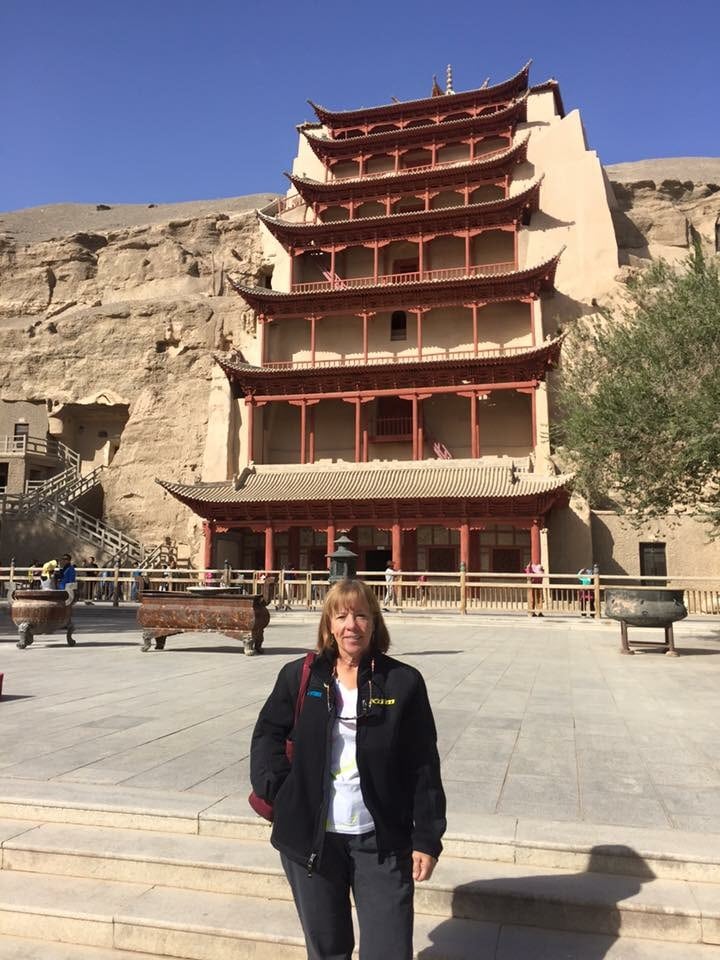
Around 1900, scholars studying the ancient Silk Road rediscovered the place, and it has become a cherished and preserved museum for ancient Buddhist culture. Even Mao and the leaders of the “Cultural Revolution” placed it at the top of their list of must-be preserves. It is hard to gain admittance. Tickets must be obtained weeks or months in advance, and each ticket is keyed to your individual passport number. Only a few tourists are admitted each day, and the caves that are open for viewing on any given day are rotated. It is the exact opposite of The Hermitage in St. Petersburg, Russia, which is literally exploding with tourists. I have been fortunate to see the Mogao Caves twice now, both times due to motorcycle trips along the Silk Road.
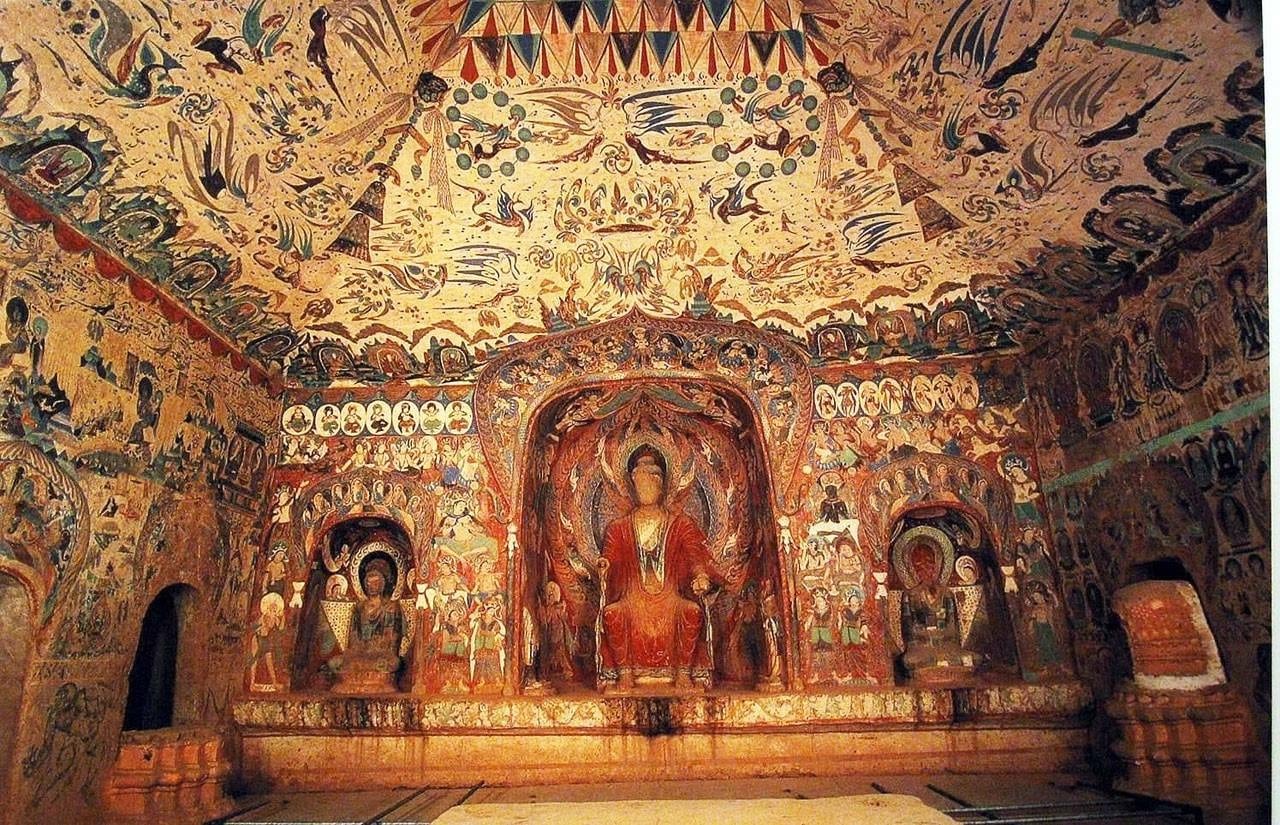
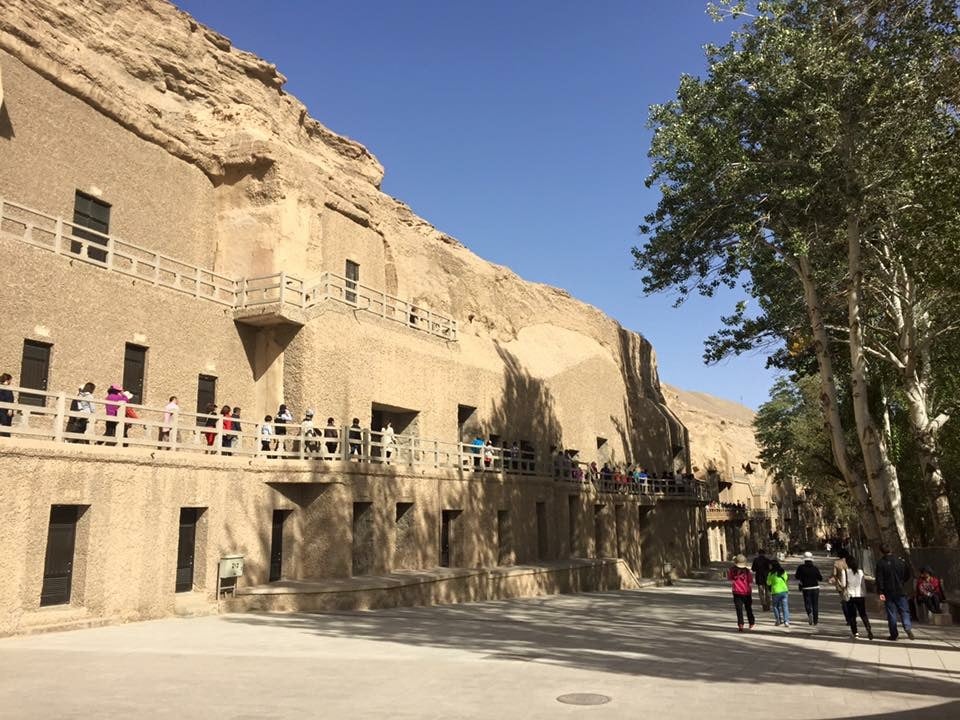
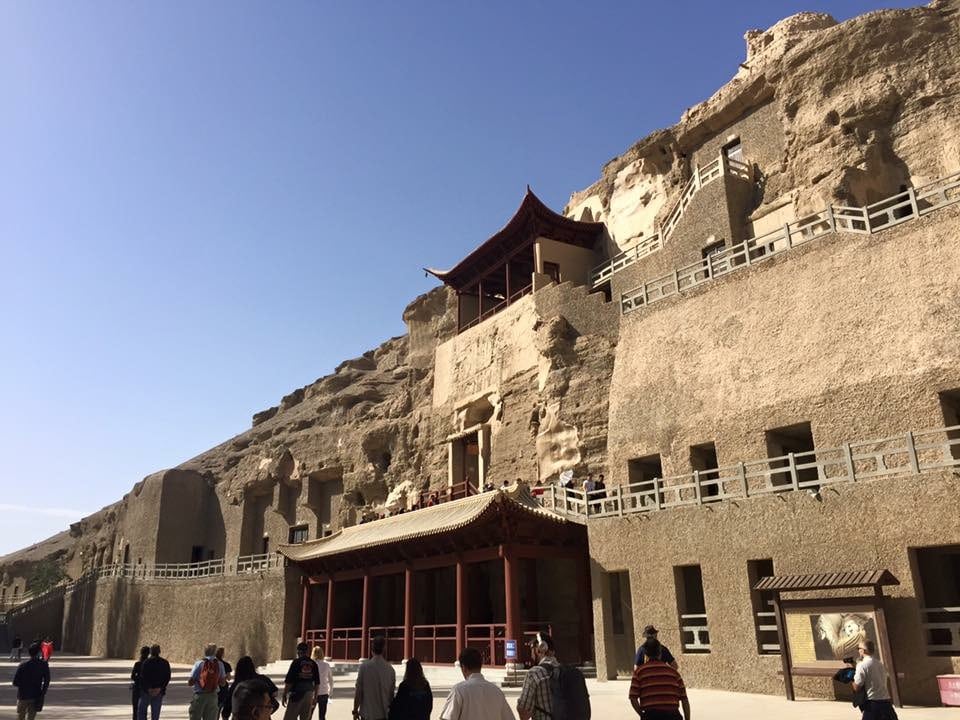
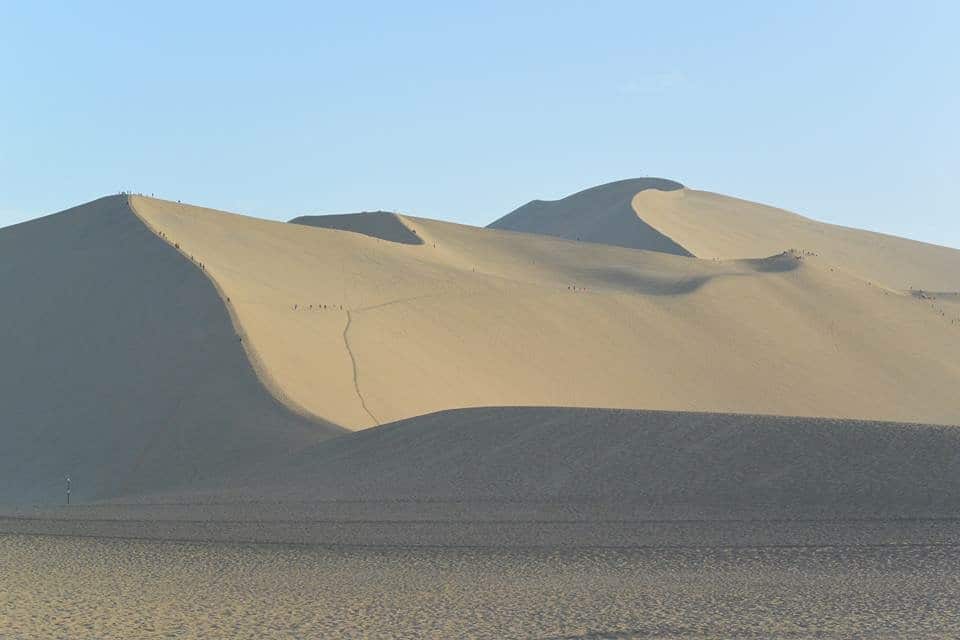
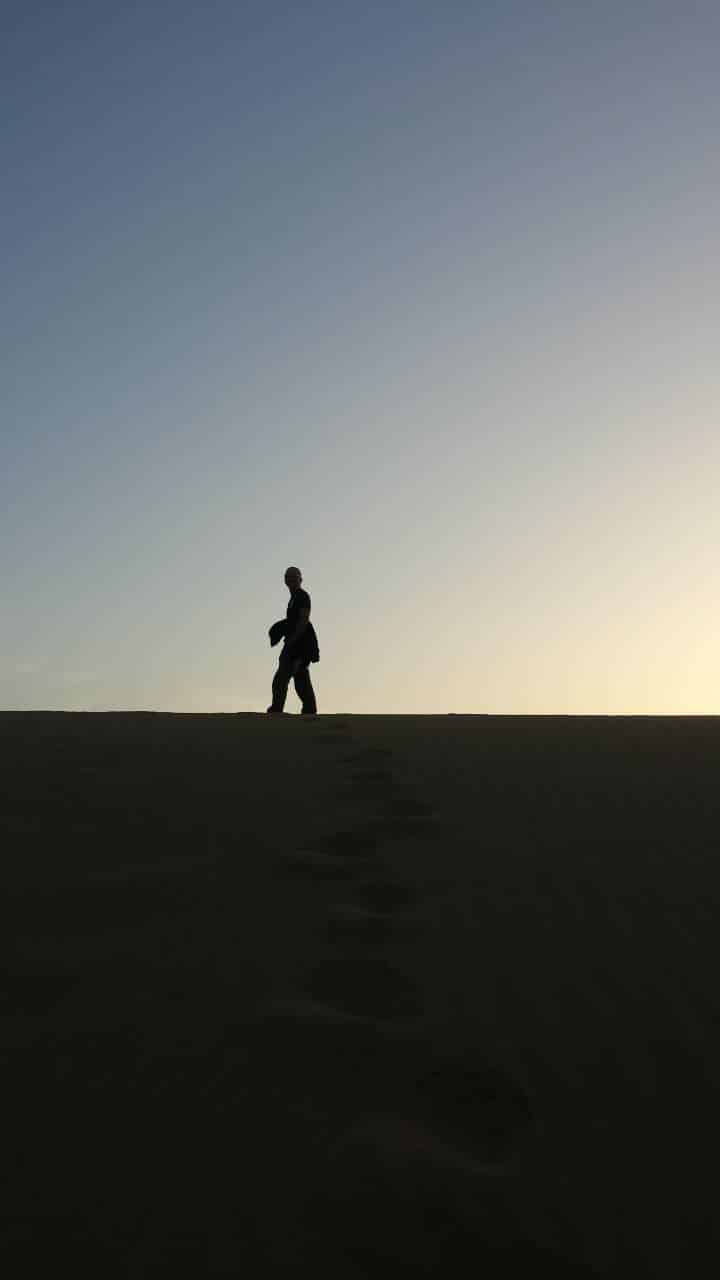
Going to Colmud. Tibetan Plateau
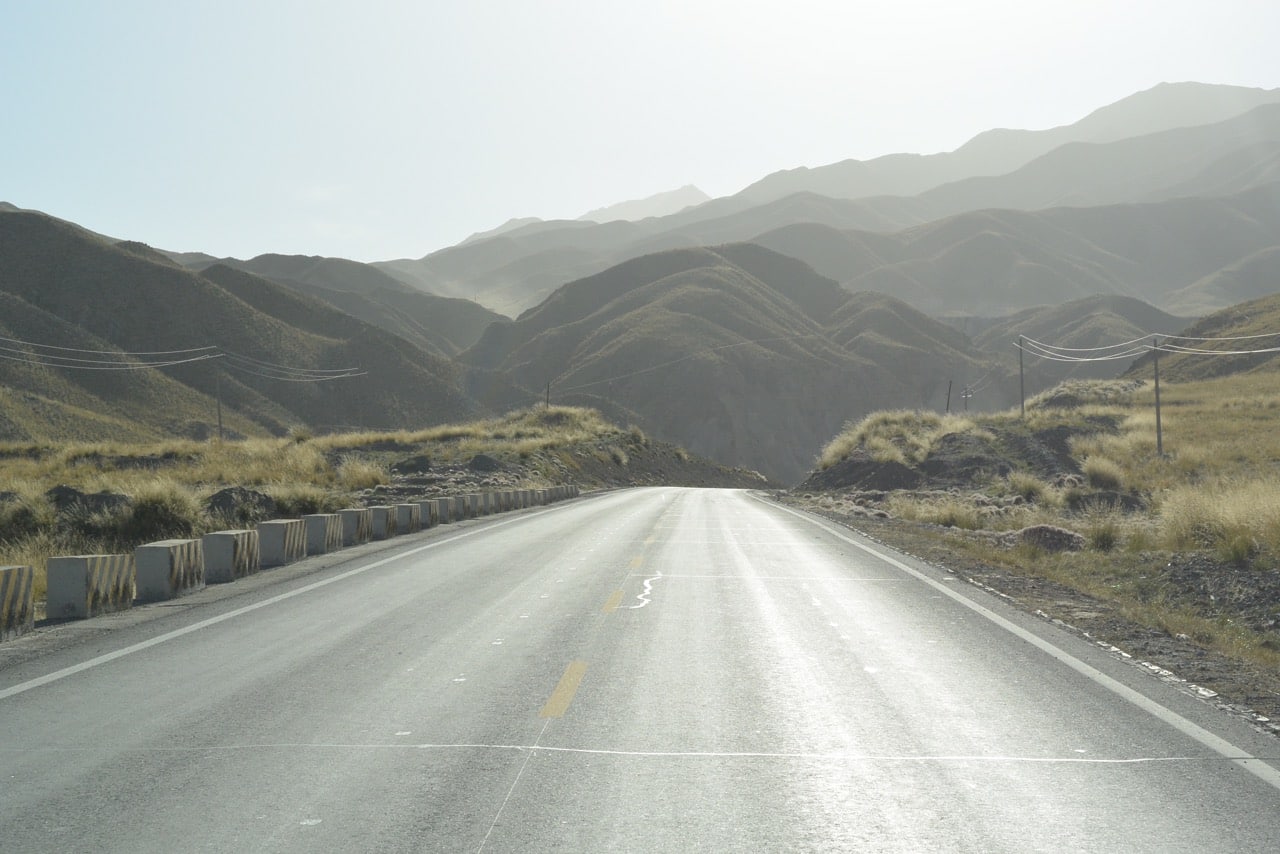 The Tibetan Plateau is a very prominent geological structure and is five time the size of France. It is sometimes called the “third pole.” It is bordered by, among other things, the Himalaya mountains and the Gobi desert. As a plateau, it varies between 5000 and 16,000 feet in altitude. Today we rode through barren, desolate desert on perfect, new multi-lane highways, with little traffic, for 350 miles at 90 to 100 mph. It was cold. The temp ranged from 49 to 70 degrees. But for some wind turbines, a railroad track under construction and power lines, we could have been on Mars. It was quite beautiful in a scary way. You would not want to be making this trip be camel, although many did. We climbed to about 10,000 feet to get here and my altimeter app says that I am sitting in a hotel room at 9300 feet.
The Tibetan Plateau is a very prominent geological structure and is five time the size of France. It is sometimes called the “third pole.” It is bordered by, among other things, the Himalaya mountains and the Gobi desert. As a plateau, it varies between 5000 and 16,000 feet in altitude. Today we rode through barren, desolate desert on perfect, new multi-lane highways, with little traffic, for 350 miles at 90 to 100 mph. It was cold. The temp ranged from 49 to 70 degrees. But for some wind turbines, a railroad track under construction and power lines, we could have been on Mars. It was quite beautiful in a scary way. You would not want to be making this trip be camel, although many did. We climbed to about 10,000 feet to get here and my altimeter app says that I am sitting in a hotel room at 9300 feet.
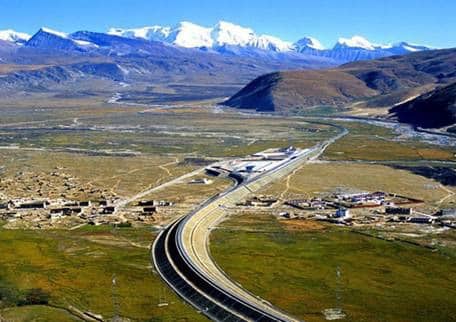 We rode past several salt lakes to get into the city. One lake is 2261 square miles, making it the largest salt lake in the world! Salt is a major industry here, producing potassium, magnesium and salt. They also have oil and gas production and precious metal mining. Surprisingly, this is a fairly modern city. Although there were no hotels for foreigners a few short years ago, we are in a “Doubletree by Hilton” that I would rate at 4 stars.
We rode past several salt lakes to get into the city. One lake is 2261 square miles, making it the largest salt lake in the world! Salt is a major industry here, producing potassium, magnesium and salt. They also have oil and gas production and precious metal mining. Surprisingly, this is a fairly modern city. Although there were no hotels for foreigners a few short years ago, we are in a “Doubletree by Hilton” that I would rate at 4 stars.
I’s stoked about seeing the mountains that border Tibet tomorrow. I hope we don’t run into a dust storm like the one in the photo, which was taken just a few months ago in Golmud on a day I’m glad I missed! (by Randy McClanahan)

Lunch stop at the Qinghai-Tibet Plateau
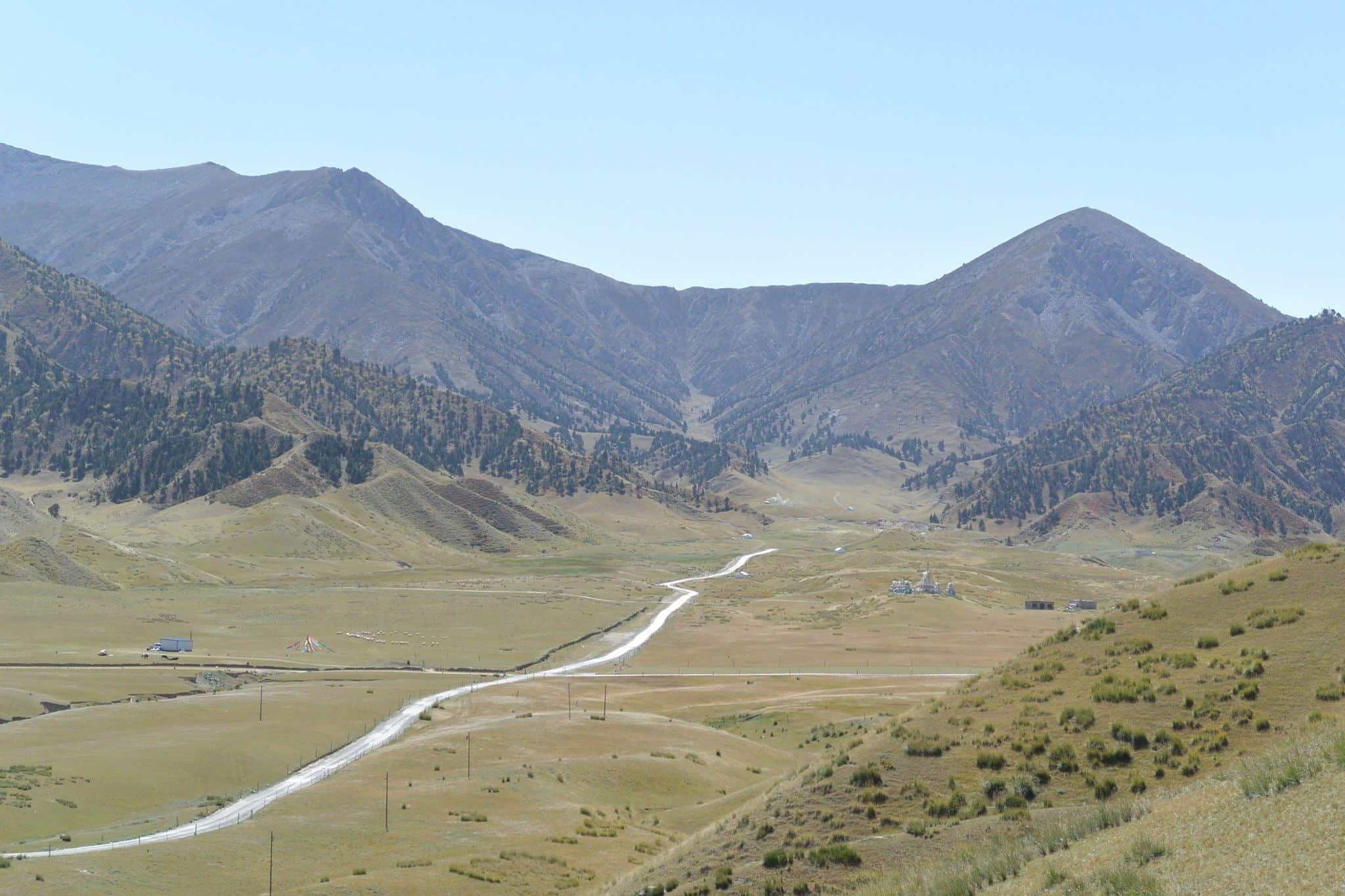
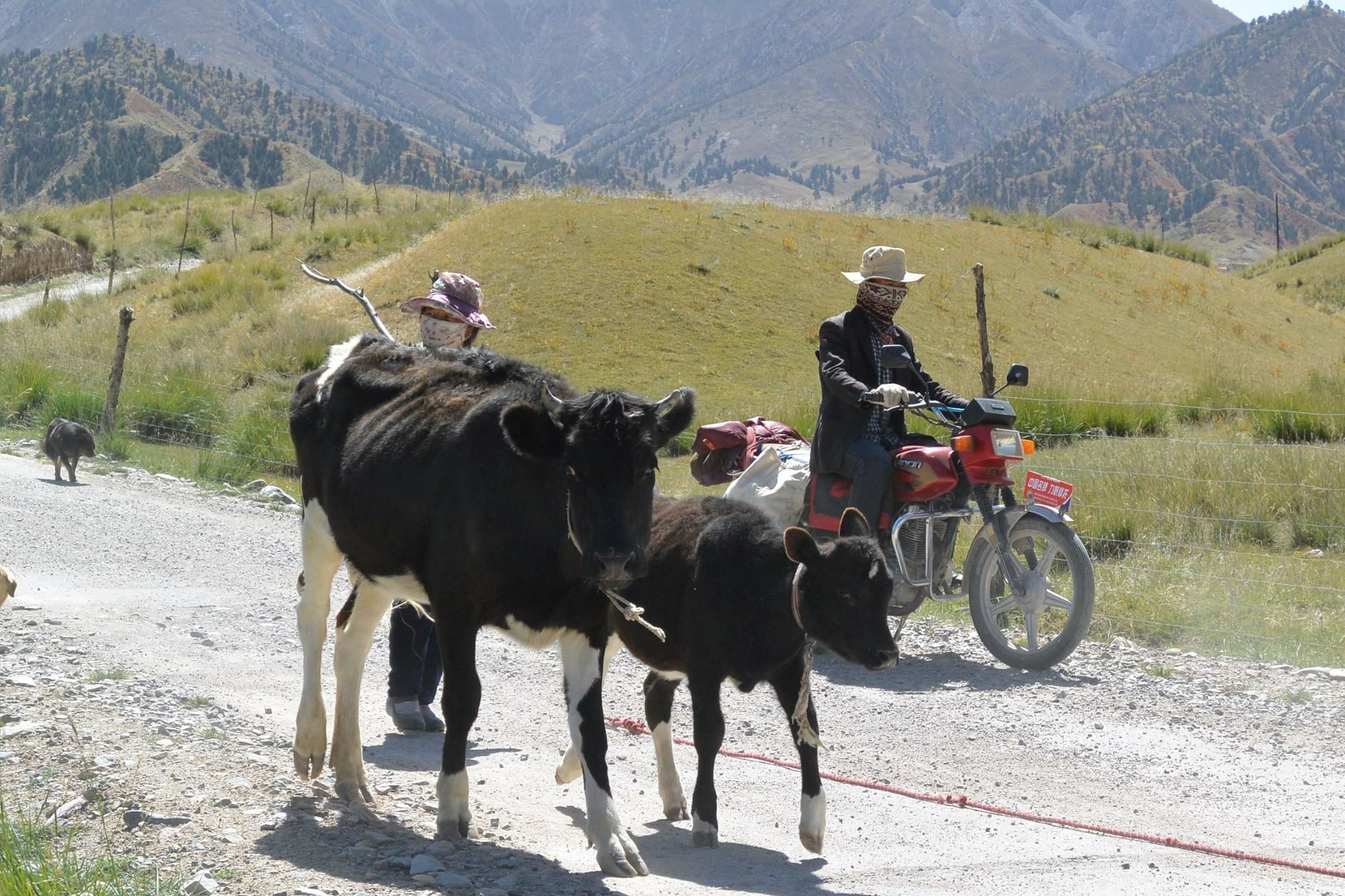
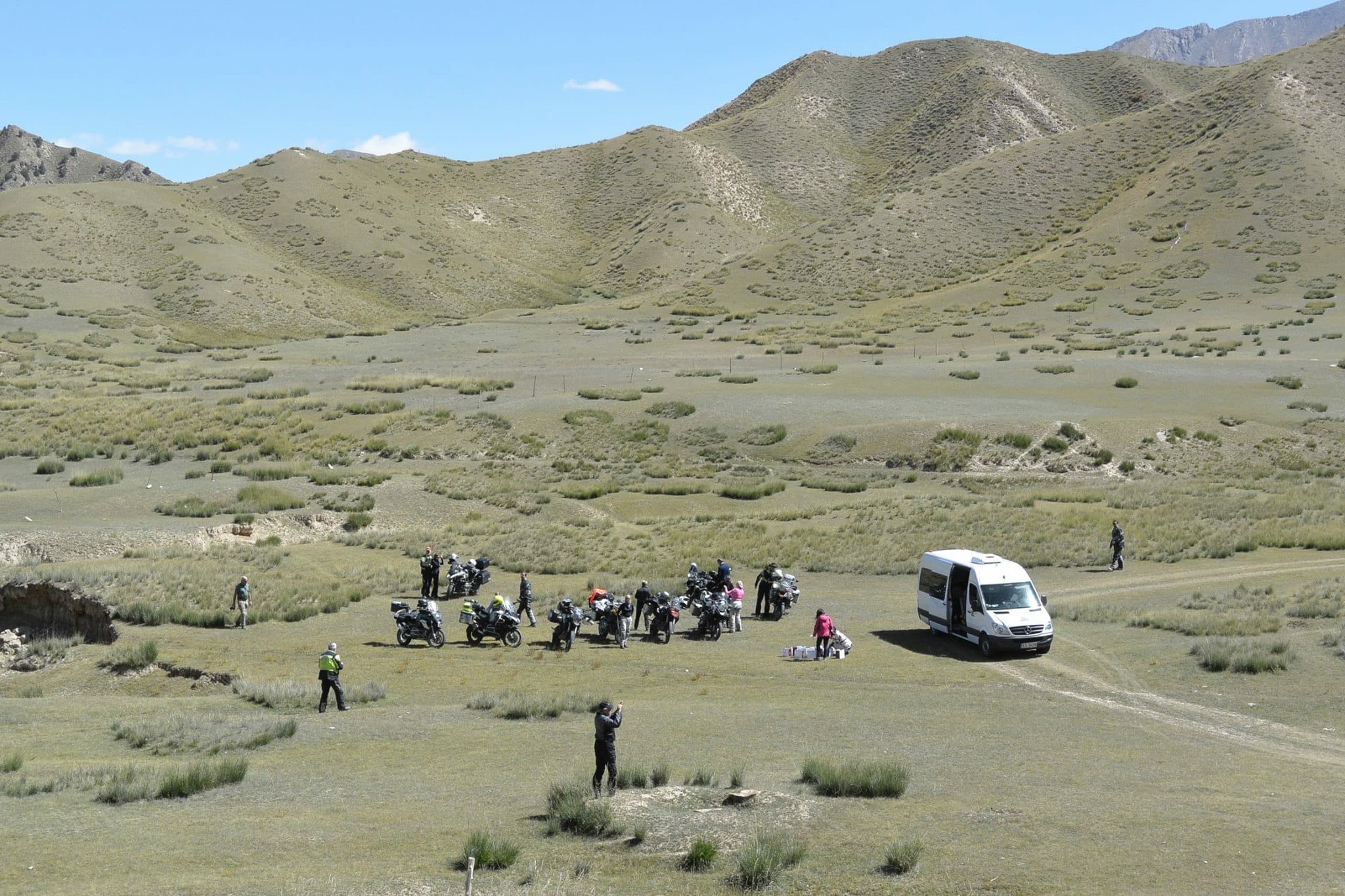 Lunch stop on the Tibetan High Plateau in the foothills of China’s Himalayas. The next few days we’ll be riding though Tibetan villages and amazing scenery. (by David Fick)
Lunch stop on the Tibetan High Plateau in the foothills of China’s Himalayas. The next few days we’ll be riding though Tibetan villages and amazing scenery. (by David Fick)
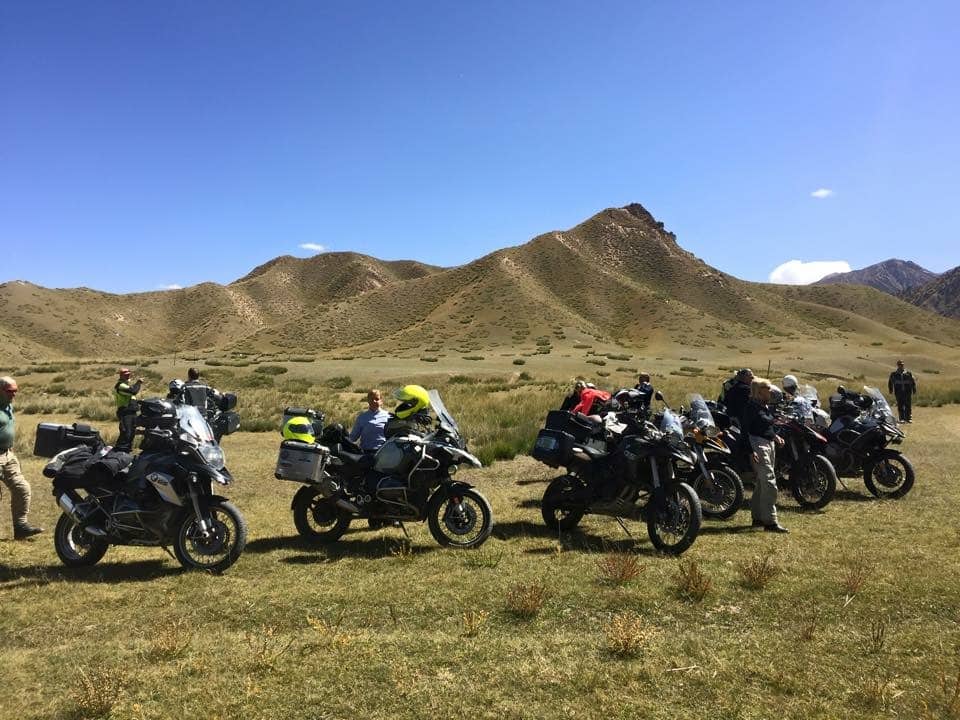
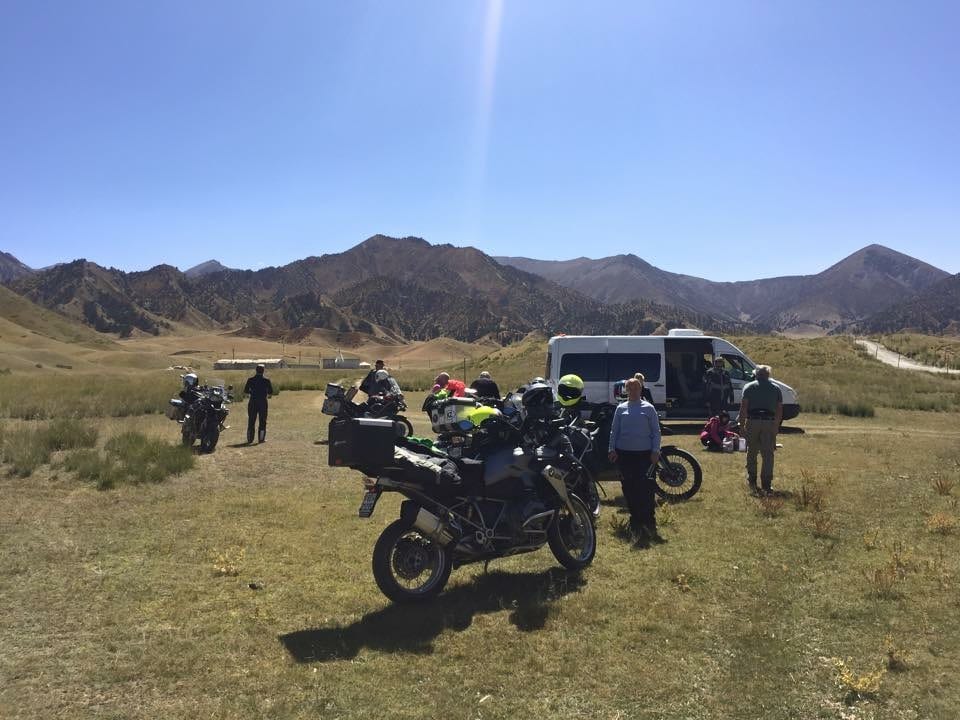 Dulan
DulanWe spent all day riding east along the edge of the Tibetan Plateau, with the foothills of the Himalayas on our right all day. To the left was very harsh looking desert. Today’s road was only two lanes, with many trucks, but we still made very good time because of no speed limit enforcement! We rode on China National Highway 109, which runs from Beijing to Lhasa, Tibet. It is called the “Lifeline of Tibet,” as 85 percent of the goods into and out of Tibet travel this road. That explains all the trucks! The alleged effects of global warming are under intense study here, so don’t think the Chinese are doing nothing about it.
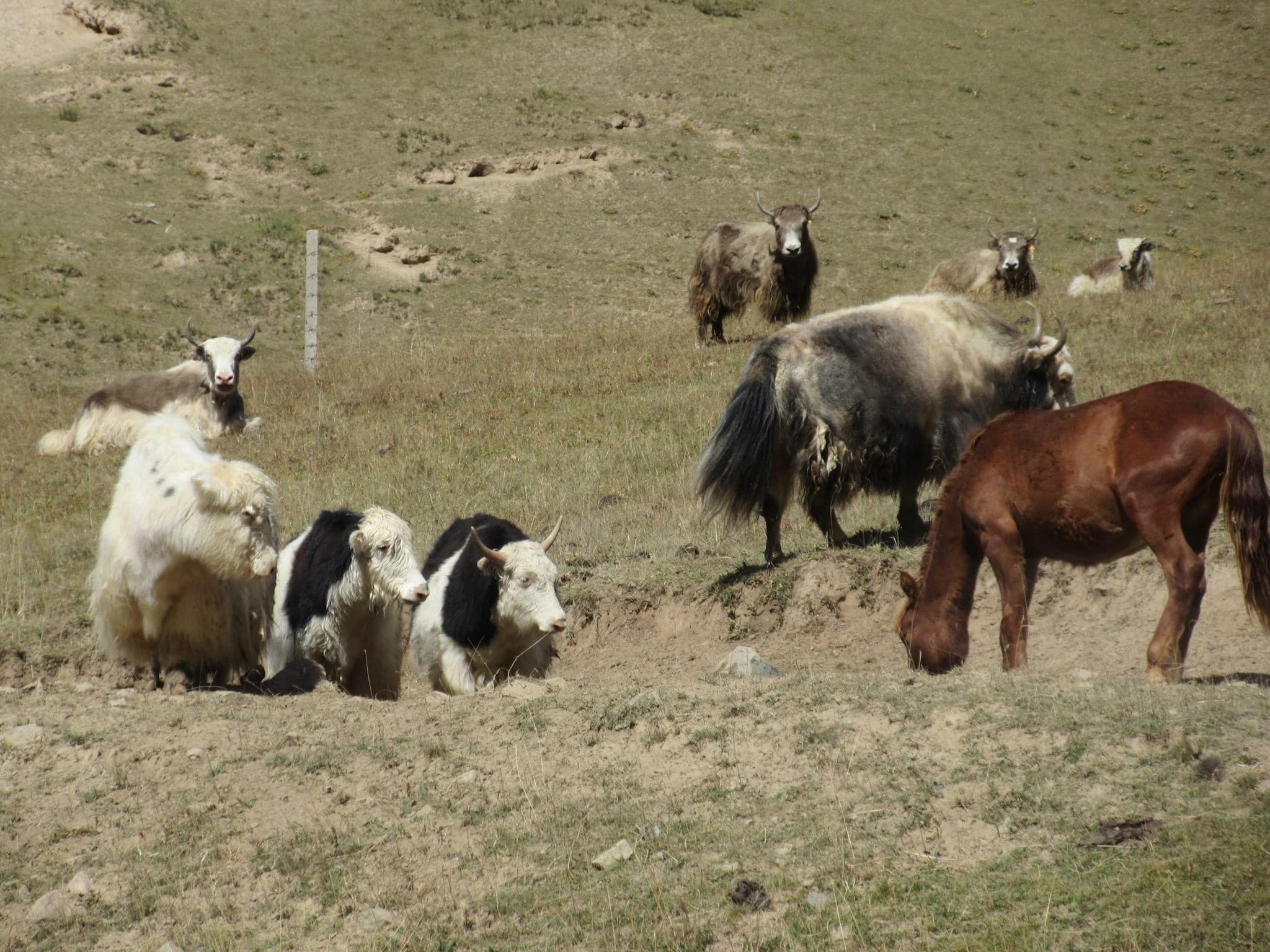 We are in a small town called Dulan for the night. My altimeter says it is 10,452 feet. A few miles before town we rode into the foothills for some nice views. We had a leisurely picnic near the Tibetan border, saw a nice monastery and Buddhist shrine, and herded animals, including cattle, yaks, goats and sheep. To me, the herders here look more like what I think of as Tibetan. They also have a darker complexion that the other Chinese rural people I have seen. Also, as we are way out in the boonies, we are back to gassing the bikes with the dreaded “tea kettles.” Not allowed to use the pumps directly into the bikes’ tanks.
We are in a small town called Dulan for the night. My altimeter says it is 10,452 feet. A few miles before town we rode into the foothills for some nice views. We had a leisurely picnic near the Tibetan border, saw a nice monastery and Buddhist shrine, and herded animals, including cattle, yaks, goats and sheep. To me, the herders here look more like what I think of as Tibetan. They also have a darker complexion that the other Chinese rural people I have seen. Also, as we are way out in the boonies, we are back to gassing the bikes with the dreaded “tea kettles.” Not allowed to use the pumps directly into the bikes’ tanks.
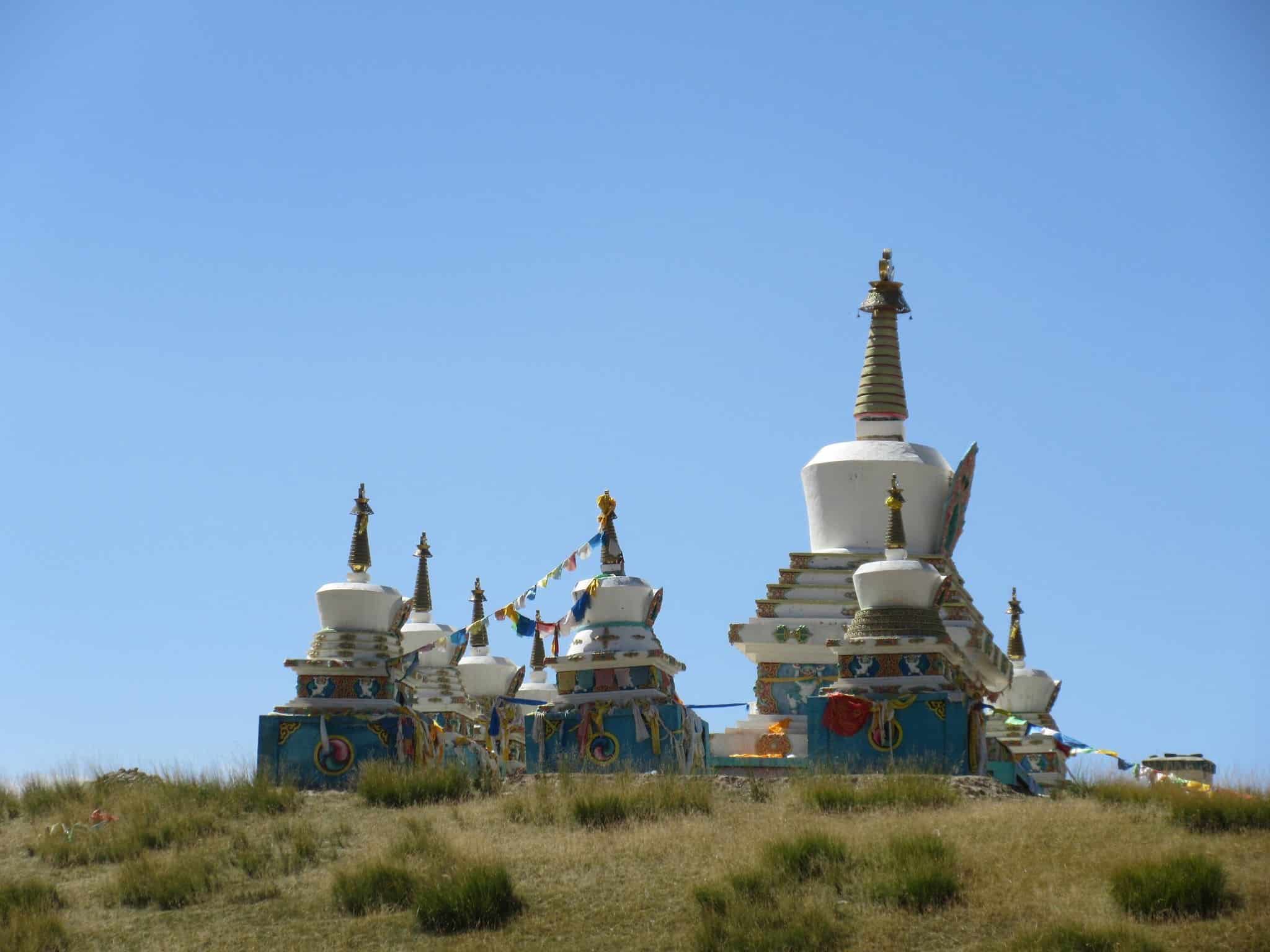 Just beyond the sign at which I am standing is Tibet! We have been warned to be extra-vigilant in locking down the bikes, as there is a history of motorcycle theft here, and once the bikes cross the border into Tibet, they disappear forever! (by Randy McClanahan)
Just beyond the sign at which I am standing is Tibet! We have been warned to be extra-vigilant in locking down the bikes, as there is a history of motorcycle theft here, and once the bikes cross the border into Tibet, they disappear forever! (by Randy McClanahan)
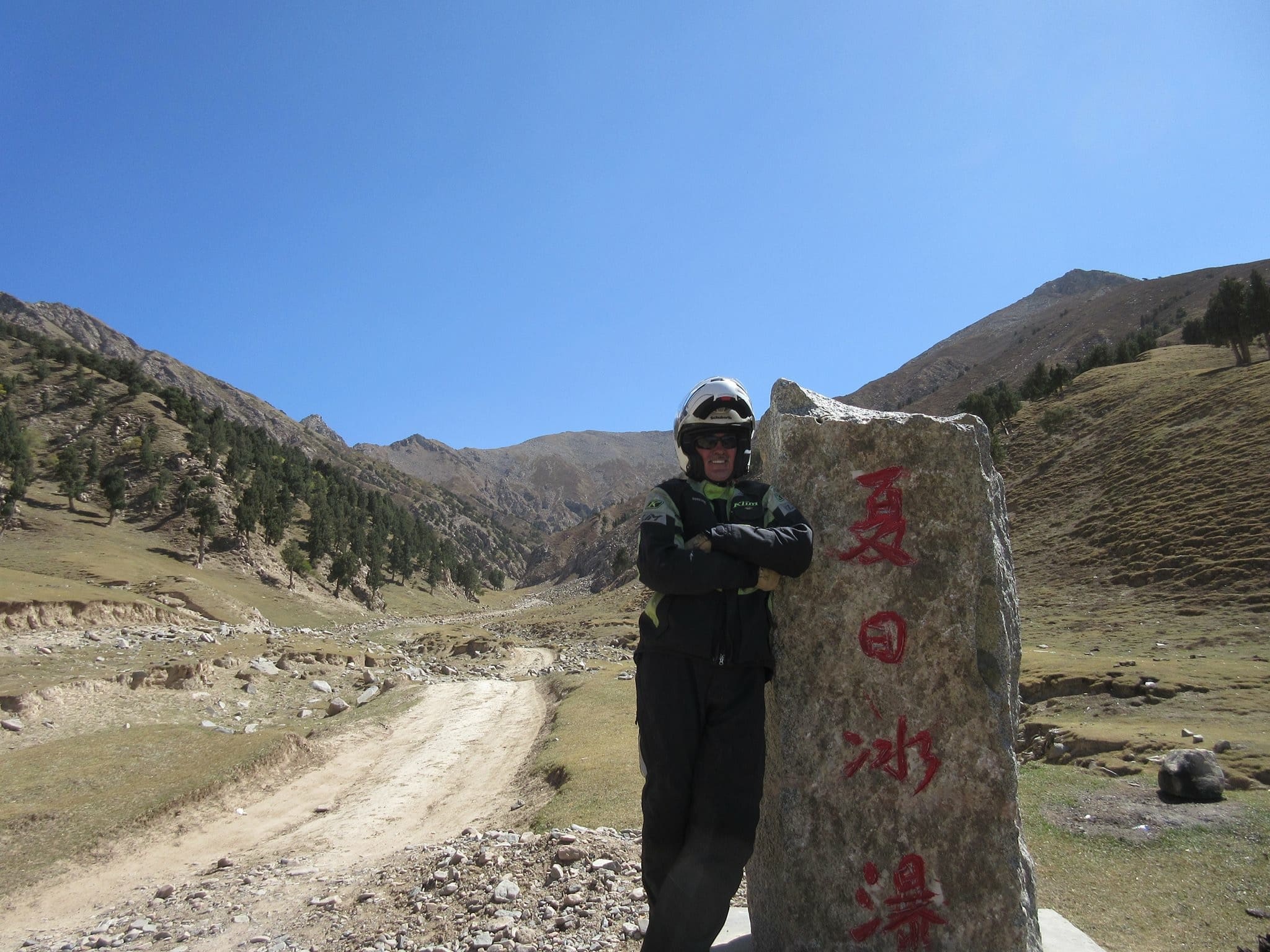 The last two days have been spent above 9-10 thousand feet on the Tibetan Plateau at the base of the Himalayas. It’s strange to look around and see the peaks above 16 thousand feet. (by Mike Meyers)
The last two days have been spent above 9-10 thousand feet on the Tibetan Plateau at the base of the Himalayas. It’s strange to look around and see the peaks above 16 thousand feet. (by Mike Meyers)
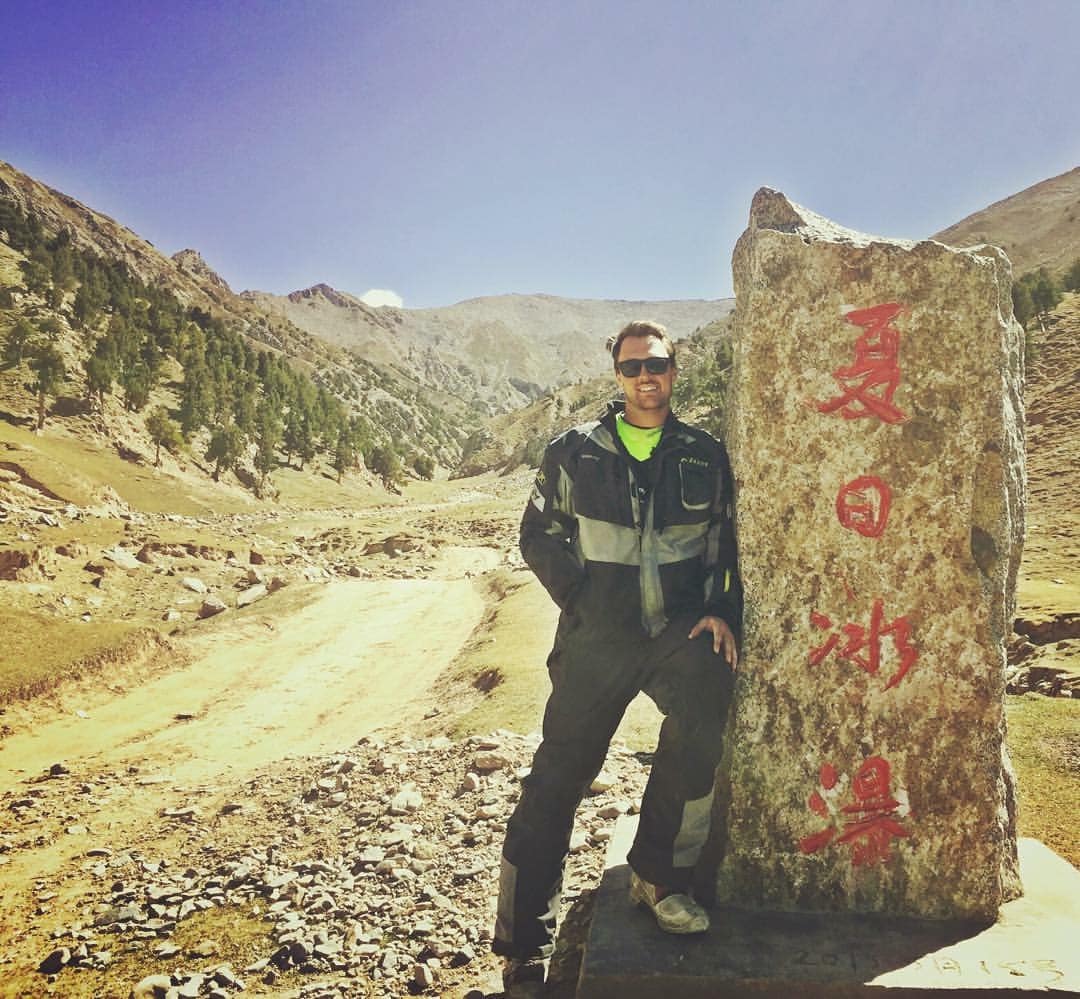 Yak attack in the Tibetan highlands. Also I’m freezing. That is all. (by Mike Meyer)
Yak attack in the Tibetan highlands. Also I’m freezing. That is all. (by Mike Meyer)
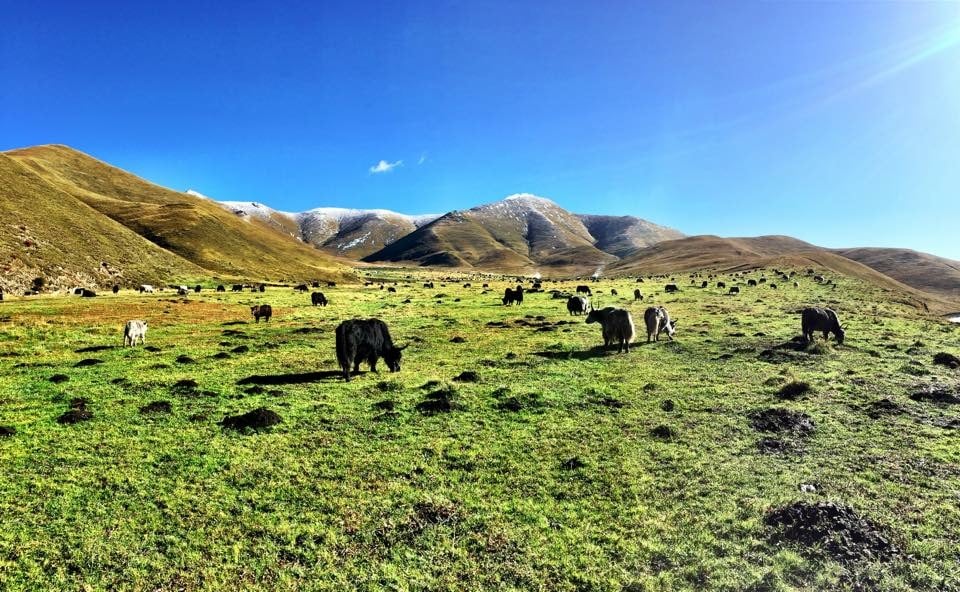
Huangyuan. Piligrim’s Path
Today’s ride felt like we were in Tibet. Of course, we almost are. We were surrounded by mountains all day as we headed east. Those trucks carrying goods to and from Tibet numbered in the thousands. Trucks outnumbered cars ten to one. They struggled to get up and down the mountains. One pass, at Xiangpi Mountain, exceeded 13,000 feet. Heavily laden trucks labored uphill with wheels barely moving, and struggled downhill with their brakes smoking. When one truck broke down, they jammed up by the dozens trying to get around it.
This is a very religious area. We constantly passed Tibetan Buddhist monasteries, shrines and prayer flags. Herds of yaks, goats and sheep grazed and crossed the road at their whim.
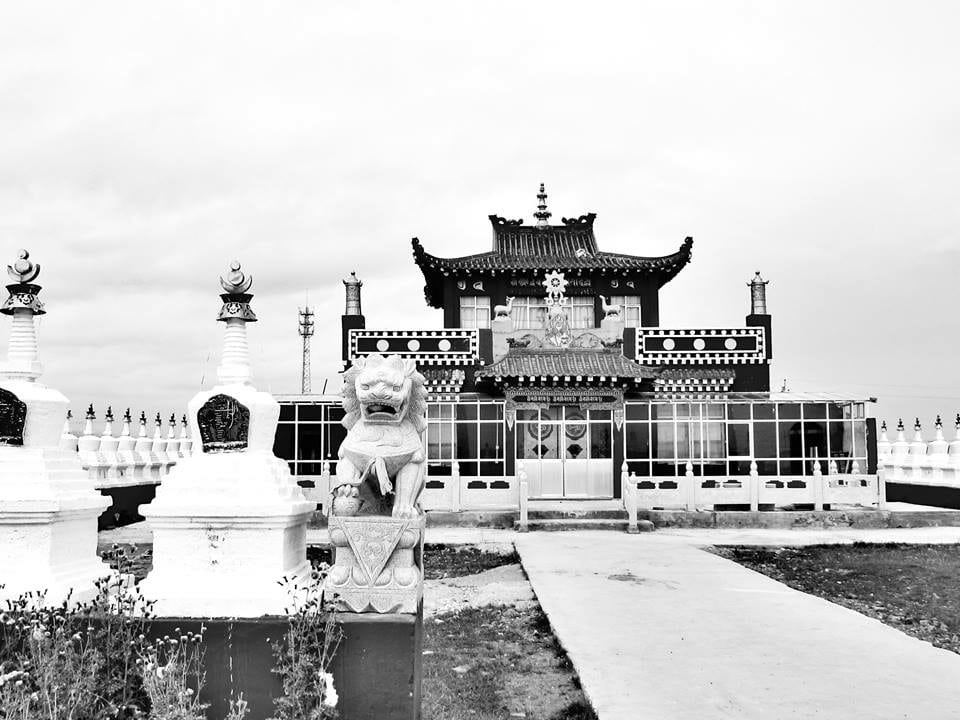 We rode along the entire southern border of Qinghai Lake, the largest lake in China. It is about the size of Rhode Island. It is a beautiful blue in color, and is considered sacred to the Buddhists in this area. So sacred, in fact, that the most devout make a pilgrimage by walking, in a clockwise direction, around the entire lake. 211 miles, just to pray and worship.
We rode along the entire southern border of Qinghai Lake, the largest lake in China. It is about the size of Rhode Island. It is a beautiful blue in color, and is considered sacred to the Buddhists in this area. So sacred, in fact, that the most devout make a pilgrimage by walking, in a clockwise direction, around the entire lake. 211 miles, just to pray and worship.
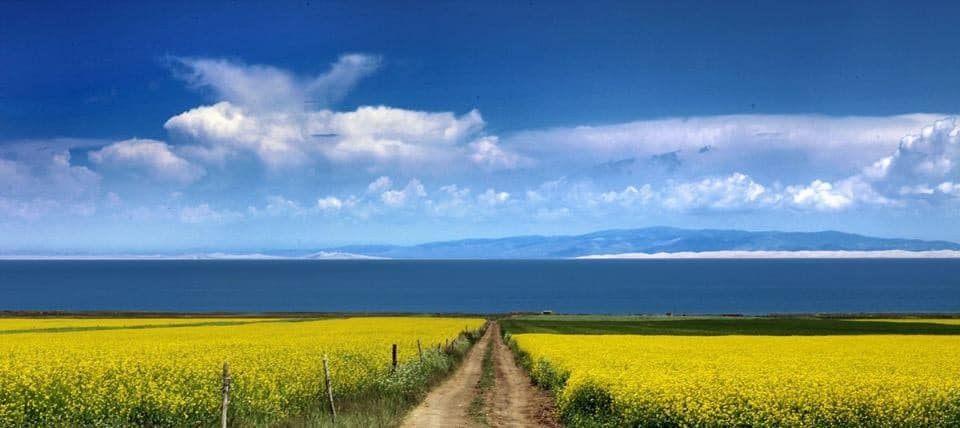 We saw individuals and groups of several dozen. Some people literally fall face down, chant a prayer, get up, walk a few feet, and do it again! Others do longer stretches prostrate. See the photo.
We saw individuals and groups of several dozen. Some people literally fall face down, chant a prayer, get up, walk a few feet, and do it again! Others do longer stretches prostrate. See the photo.
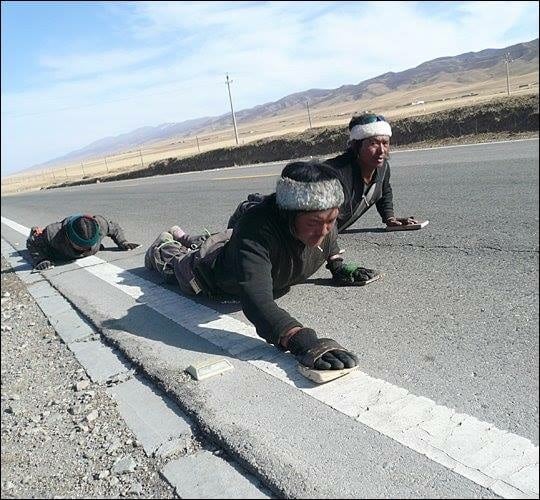
We saw a rain storm approaching, and as it had been cold all day (50’s and 60’s), we hurried to get to our night’s hotel. We are in Huangyuan. Our hotel is very basic (for example, my room has no hot water), and is on the outskirts of a large town. This is the place where, last year, our guides on their scouting trip were advised to drive their big BMW motorcycles into the marble floored hotel lobby for the night! Hopefully our eleven bikes will stay safely huddled together at the back of the hotel while we sleep. (by Randy McClanahan)
Heaven and Hell! Road to Xiahe
Today started out perfect! Clear, blue sky. 58 degrees. Dry. Recall that we usually just take secondary roads, as motorcycles are not allowed on “expressways.” The first problem today was that our secondary road was closed due to a landslide. We tried to go on a detour, which also had a landslide! So, we tried to inch around it. The first 1200 GSA, two up, did not make it. Tom, our best rider, and his wife, Mona went down into the three foot deep shoulder trench. Fortunately, six men were able to pick up the bike and we were on our way again.
We passed through a three mile tunnel, and were in Sedona, Arizona! Red rocks and cliffs everywhere. We then rode along the Yellow River for a long while, and were in the mountains all day long. As you motorcyclists know, when the weather is good, mountain riding is the best there is. When the weather or road is not great, it sucks. In the morning, as we rode through Kanbula National Park, it was like being in the Alps. The morning presented the best riding we have had thus far in this trip! Switchbacks, fast twisties, incredible views, perfect weather.
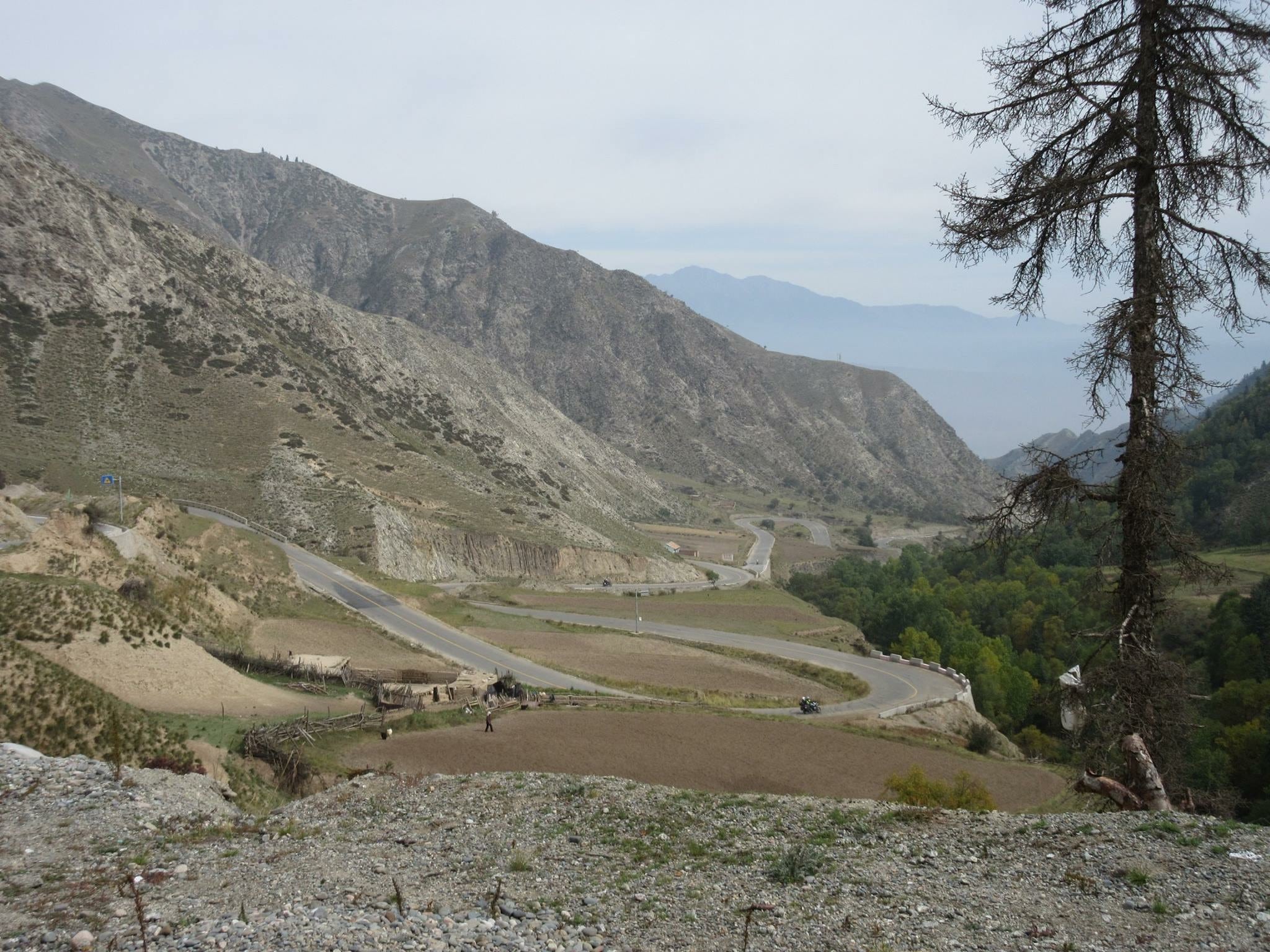 We rode through, and past, a dam in the Yellow River. I once saw a very informative documentary about a dam on the Yangtze that displaced 300,000 Chinese. It seems that China has a dam boom underway! In search for renewable electric power, China is building about 130 hydroelectric dams, most larger than our Hoover Dam! Millions of rural peasants are being relocated to new cities, with huge populations.
We rode through, and past, a dam in the Yellow River. I once saw a very informative documentary about a dam on the Yangtze that displaced 300,000 Chinese. It seems that China has a dam boom underway! In search for renewable electric power, China is building about 130 hydroelectric dams, most larger than our Hoover Dam! Millions of rural peasants are being relocated to new cities, with huge populations.
After lunch, the rain started. Trouble enough with wet paved roads. But then we entered construction. Dirt and sand. Rain! Then a traffic jam due to a stalled blacktop machine. We found a detour, and found some single track to get to the other side of the blacktop machine. Then the pavement ended. Miles of switchbacks at altitude IN THE MUD!
We made it to Xiahe. Lots of prayers, obviously answered on my part. This was easily the most difficult riding so far. Xiahe, which is where we are for the night, is a monastic town. Only the weird come here! The monastery is the third most important in Tibetan Buddhism. You have the Dalai Lama, then one other dude, then this place. Maybe I’ll get to see it tomorrow, but for now, I’m seriously happy to be alive, after riding mud construction, in the rain, on street tires, in friggin’ China! (by Randy McClanahan)
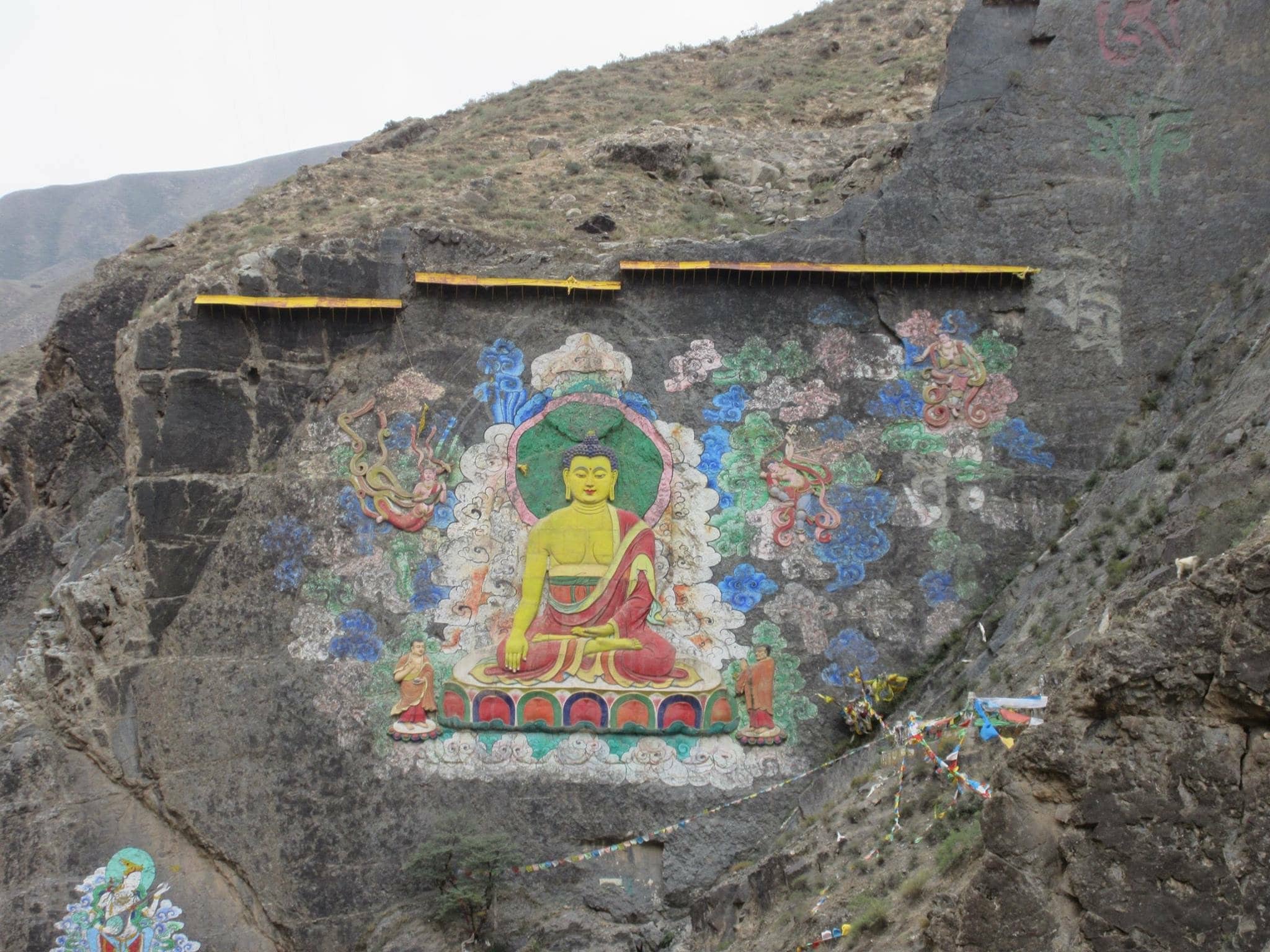 Alps-like riding today in the Tibetan areas of China. Then it rained heavily while we traversed the last 40kms through muddy construction on switchbacks, some of the hardest riding I’ve ever ever done two-up, and that’s why it’s an adventure. We can’t take pictures in the mud and rain, so you don’t see the “good” stuff, suffice it to say it involved many many sheep and yaks on the road. Yes, you can actualy push your way through milling herds of sheep with a motorcycle. (by David Fick)
Alps-like riding today in the Tibetan areas of China. Then it rained heavily while we traversed the last 40kms through muddy construction on switchbacks, some of the hardest riding I’ve ever ever done two-up, and that’s why it’s an adventure. We can’t take pictures in the mud and rain, so you don’t see the “good” stuff, suffice it to say it involved many many sheep and yaks on the road. Yes, you can actualy push your way through milling herds of sheep with a motorcycle. (by David Fick)
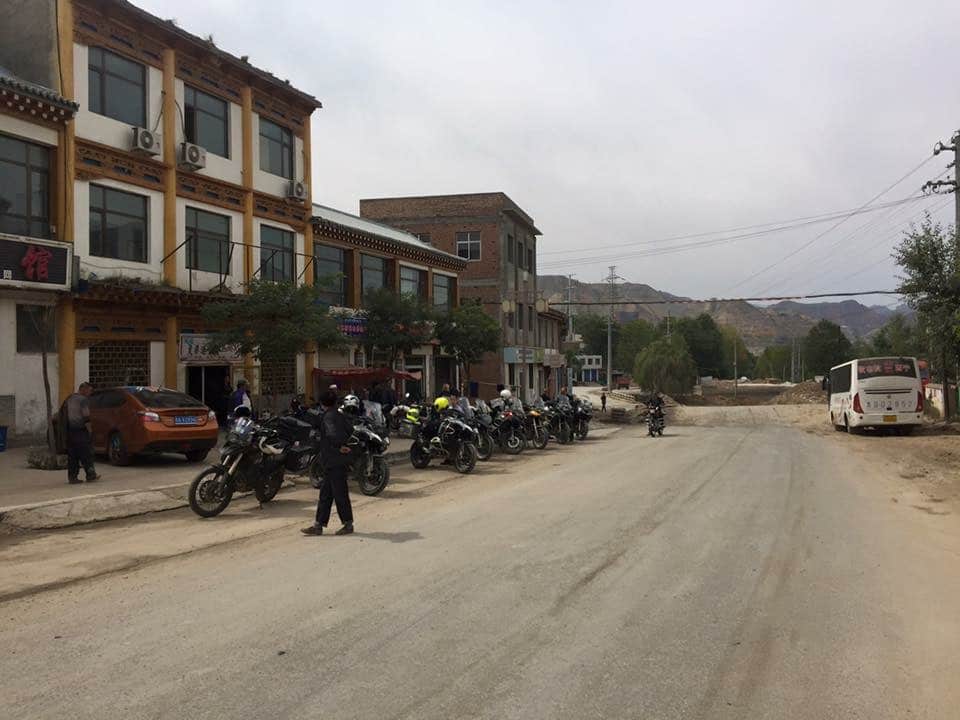
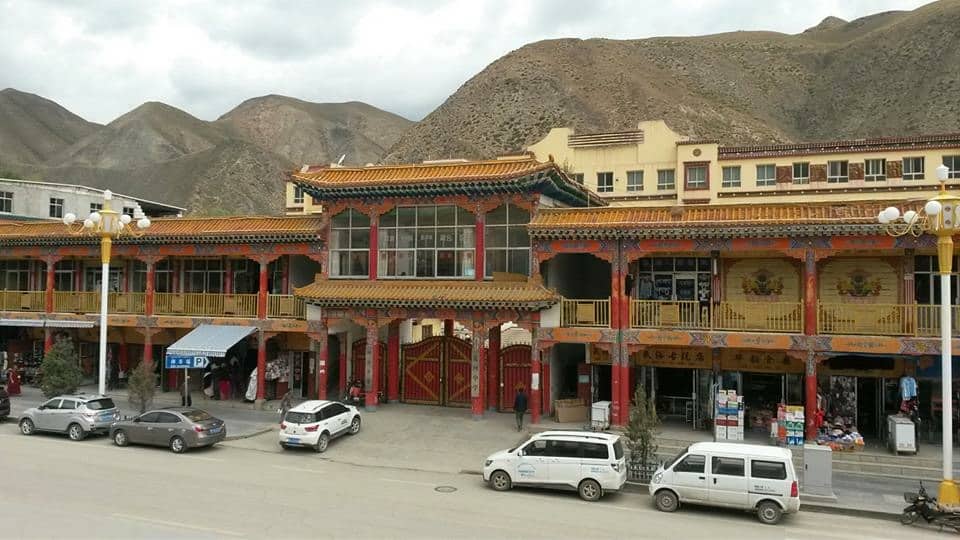
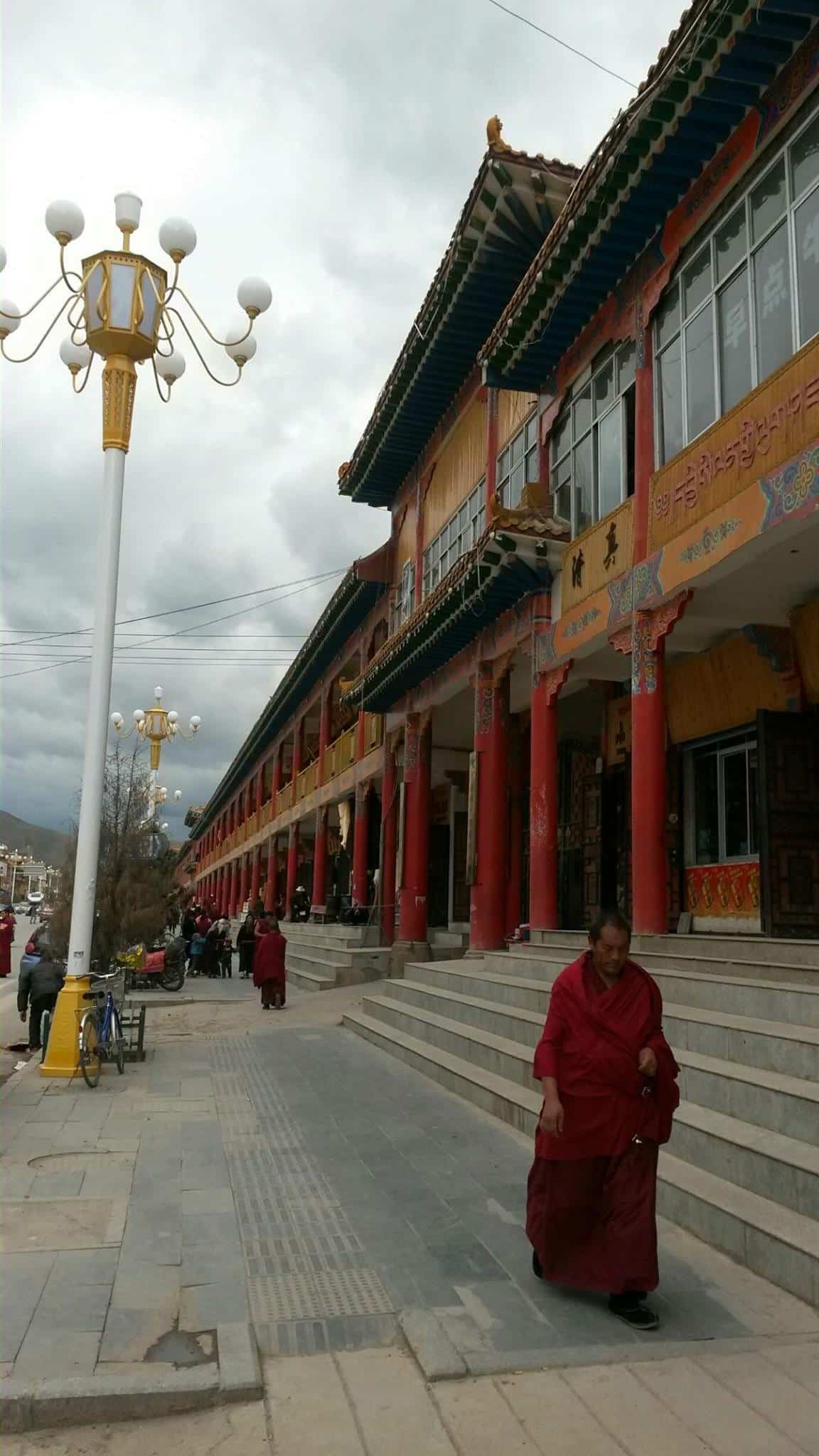
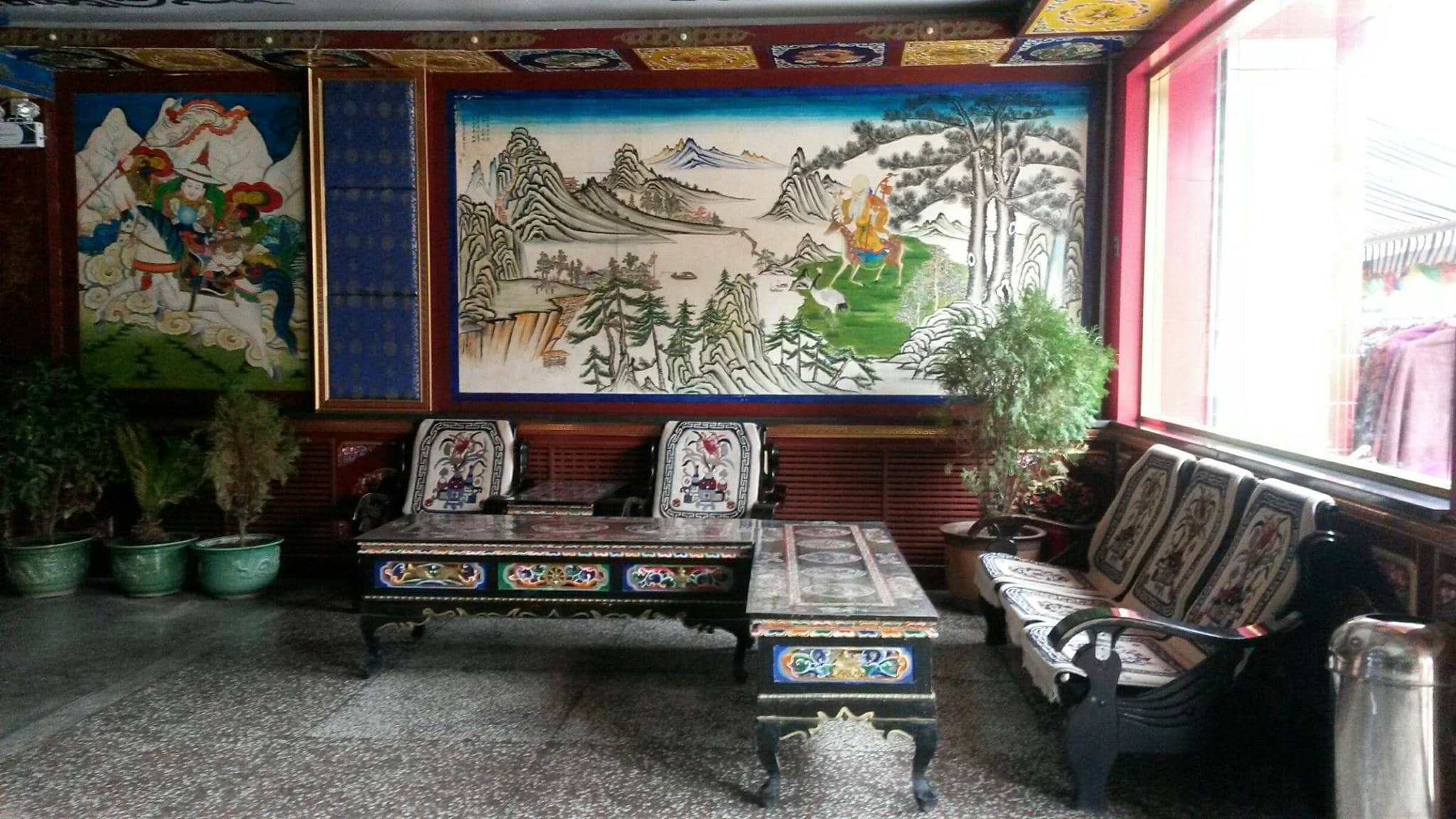
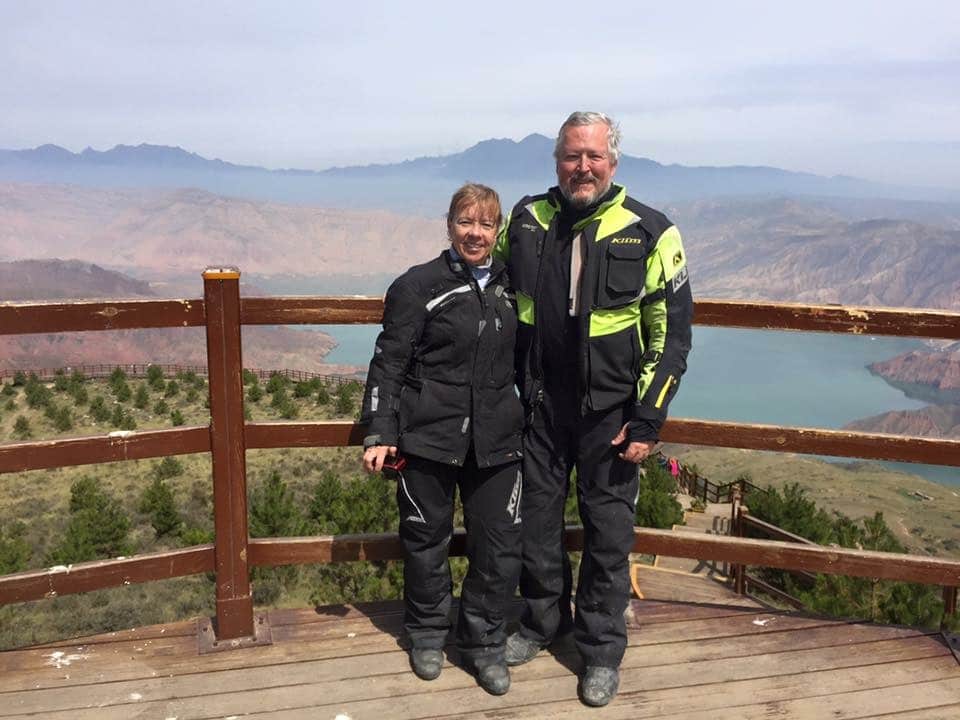
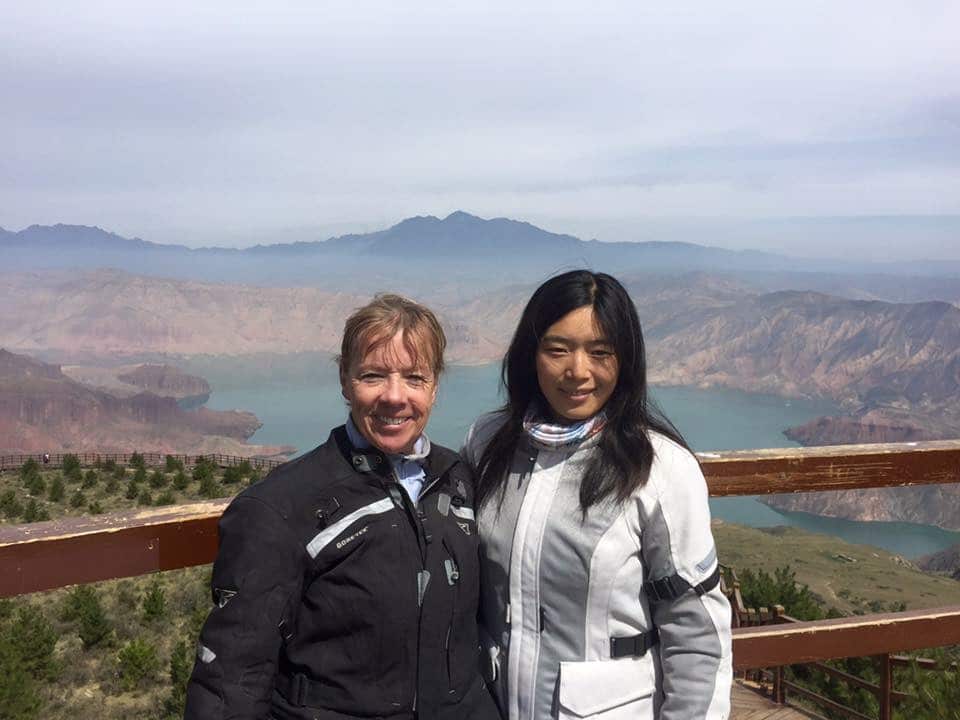

A day of Buddhists
Today began as good as yesterday ended badly. The weather was cold but perfect. 41 degrees when we hit the road, warming to the low 60s later in the day. Perfect blue sky, low humidity, no pollution. We caught a glimpse of the Labrang Monastery as we left town. It currently houses 1200 monks, and various monastic colleges where they study esoteric Buddhism, medicine, astrology and law. You can see some monks atop the gold roofed dome in the photo.
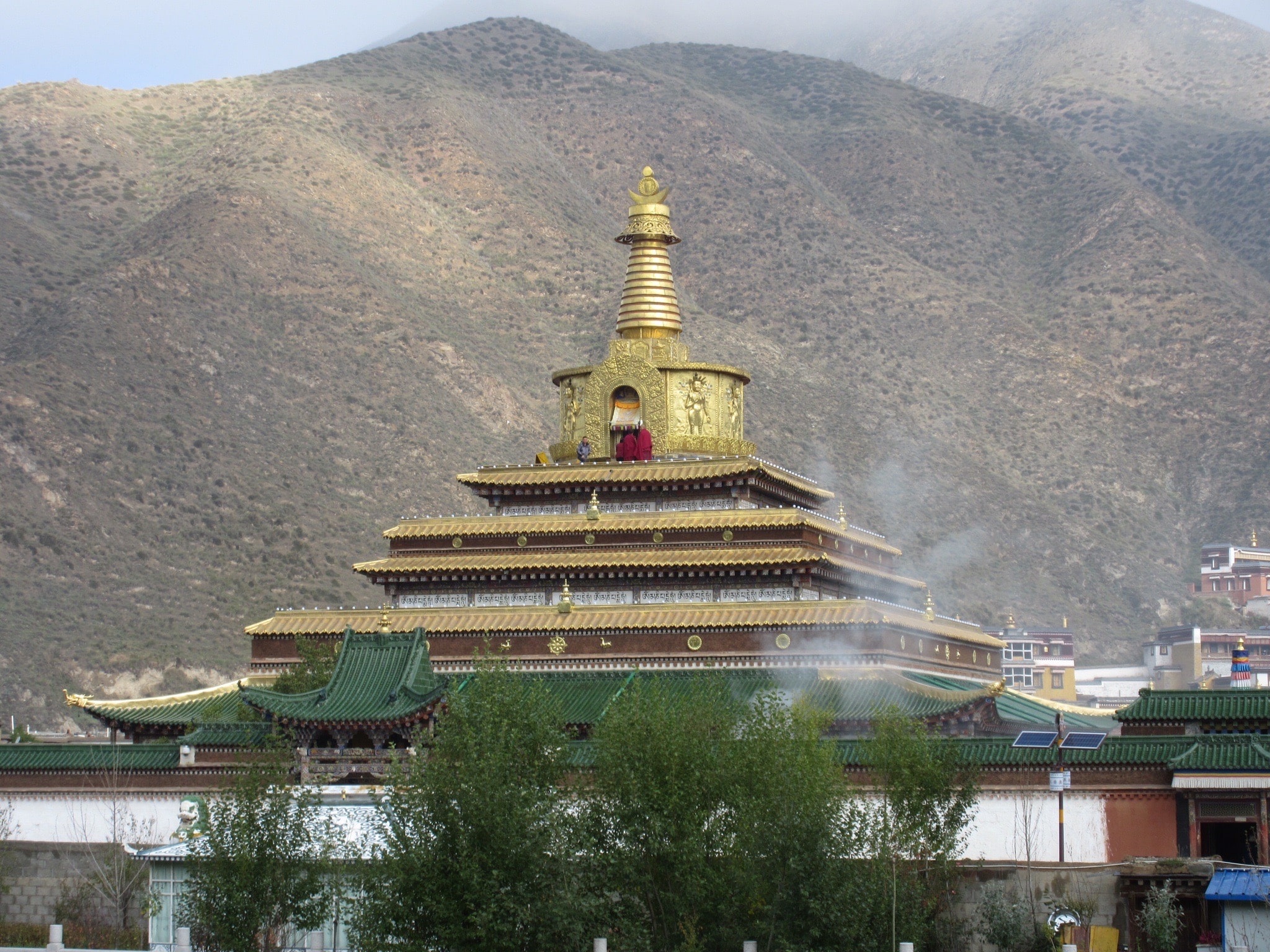 This was our last day on the Tibetan Plateau, and it was our best. Our hotel is at 11,500 feet, and we have been around that altitude all day. We passed through many rural villages, and the hills were covered with herders and their stock. Everything was green, and the sheep dotted the hillsides like white dots. Some mountain tops were covered with snow. No houses, many tents and Gers. There are no fences, and animals are constantly crossing the road. They are herded by horseback and motorcycles. Unlike cattle, yaks will bolt unexpectedly, and young goats jump into the air like deer, sometimes landing on a car or motorcycle as they land.
This was our last day on the Tibetan Plateau, and it was our best. Our hotel is at 11,500 feet, and we have been around that altitude all day. We passed through many rural villages, and the hills were covered with herders and their stock. Everything was green, and the sheep dotted the hillsides like white dots. Some mountain tops were covered with snow. No houses, many tents and Gers. There are no fences, and animals are constantly crossing the road. They are herded by horseback and motorcycles. Unlike cattle, yaks will bolt unexpectedly, and young goats jump into the air like deer, sometimes landing on a car or motorcycle as they land.
We came upon a White Pagoda. Villagers, mostly old people, sat around and circled clockwise, chanting mantras while spinning the prayer wheels as they did. So, we did the same, sans mantra. No one seemed to mind our being there. (by Randy McClanahan)
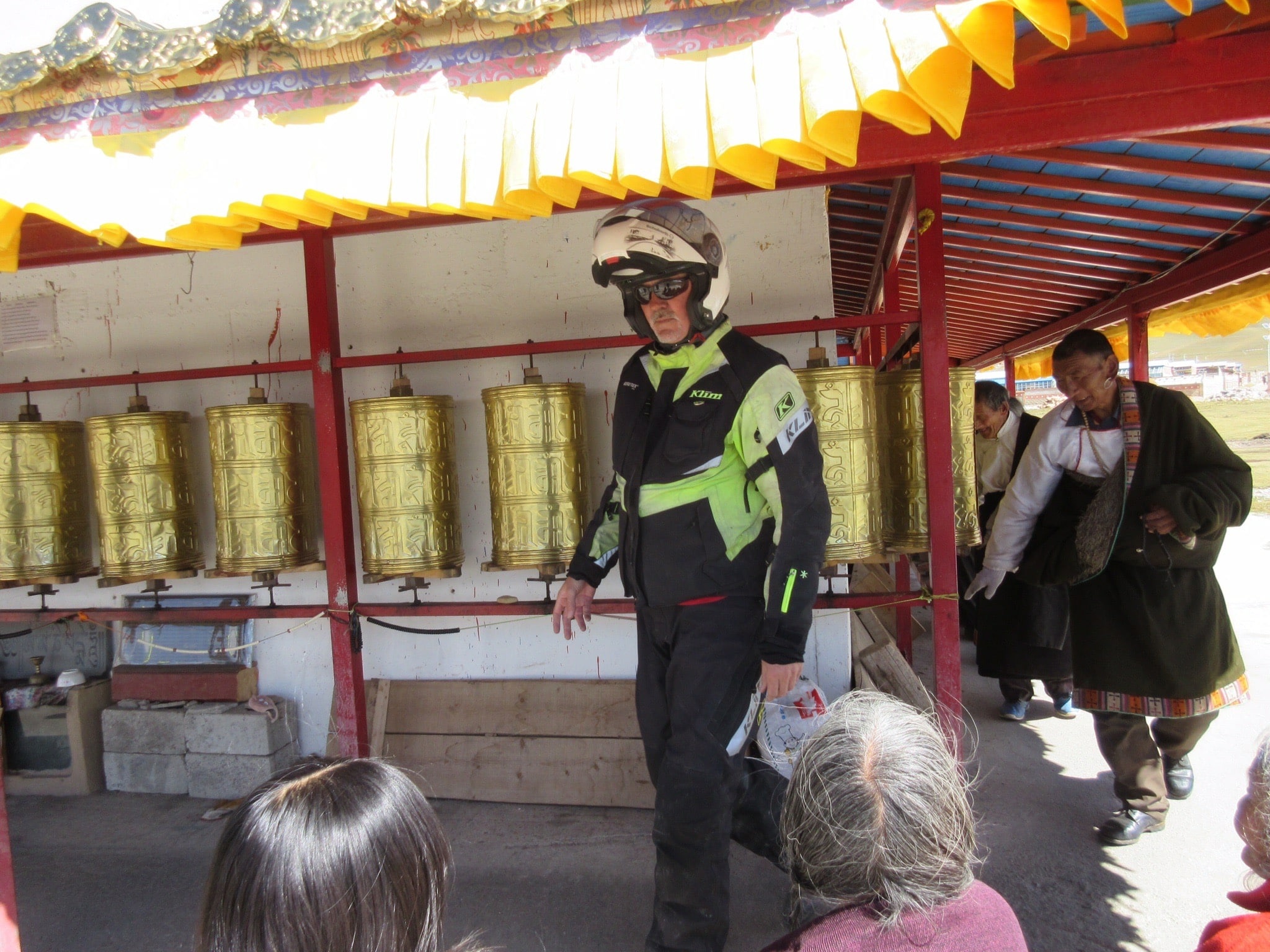 A pagoda is the general term for a tiered tower with multiple eaves, common in China, Japan, Korea, Nepal, Vietnam, and other parts of Asia. The pagoda’s original purpose was to house relics and sacred writings.
A pagoda is the general term for a tiered tower with multiple eaves, common in China, Japan, Korea, Nepal, Vietnam, and other parts of Asia. The pagoda’s original purpose was to house relics and sacred writings.
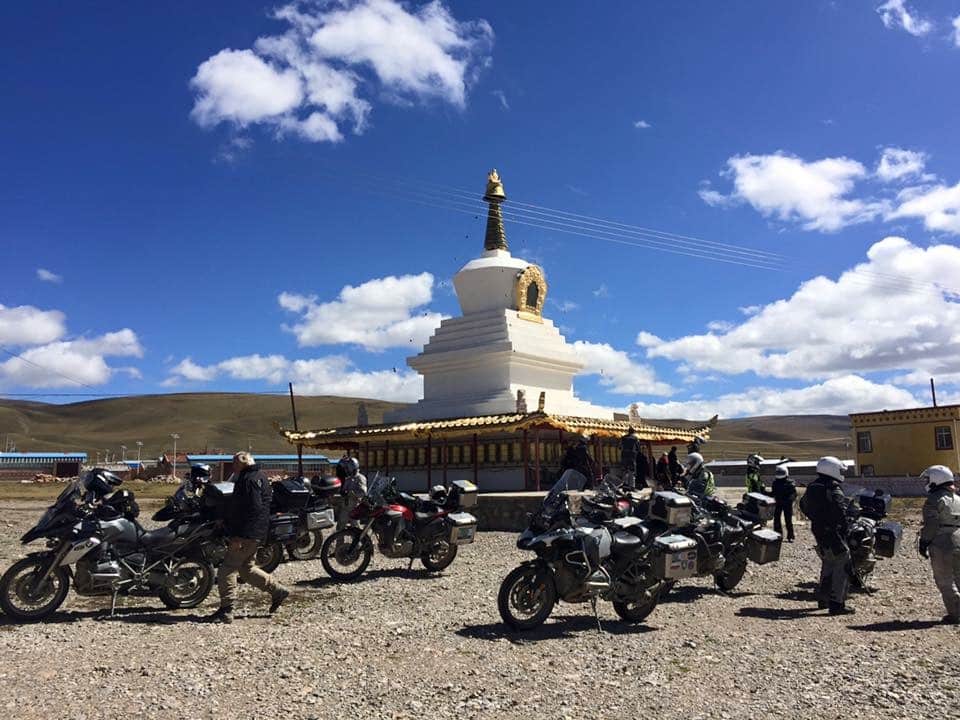 One of the coolest mornings on our adventure so far – stopped at a Tibetan Buddhist “white pagoda” where the locals walk clockwise for hours, spinning prayer drums.
One of the coolest mornings on our adventure so far – stopped at a Tibetan Buddhist “white pagoda” where the locals walk clockwise for hours, spinning prayer drums.
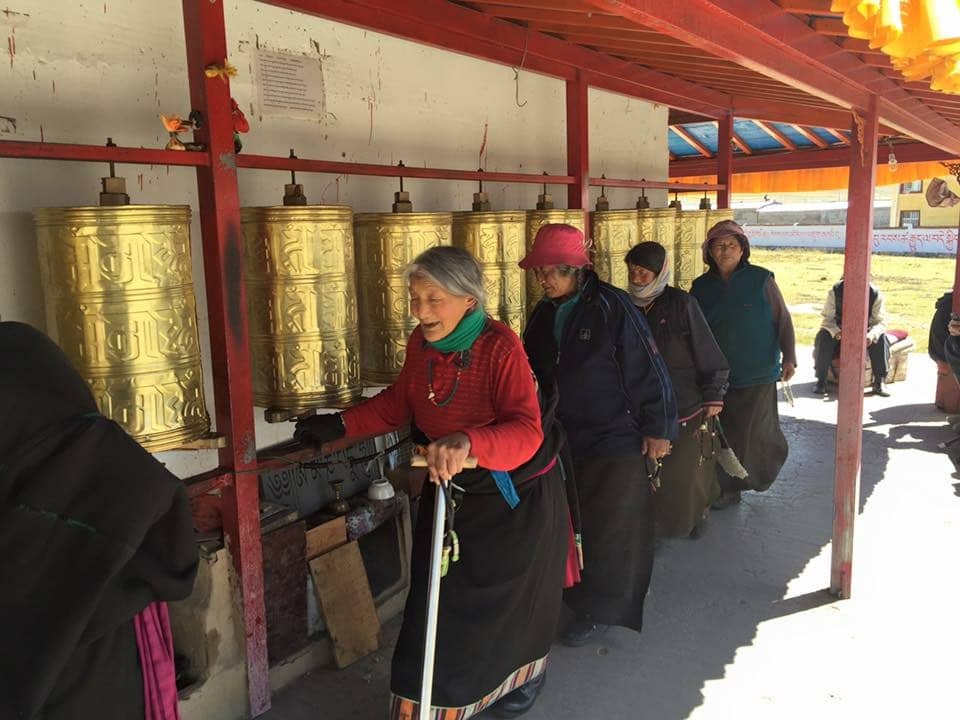
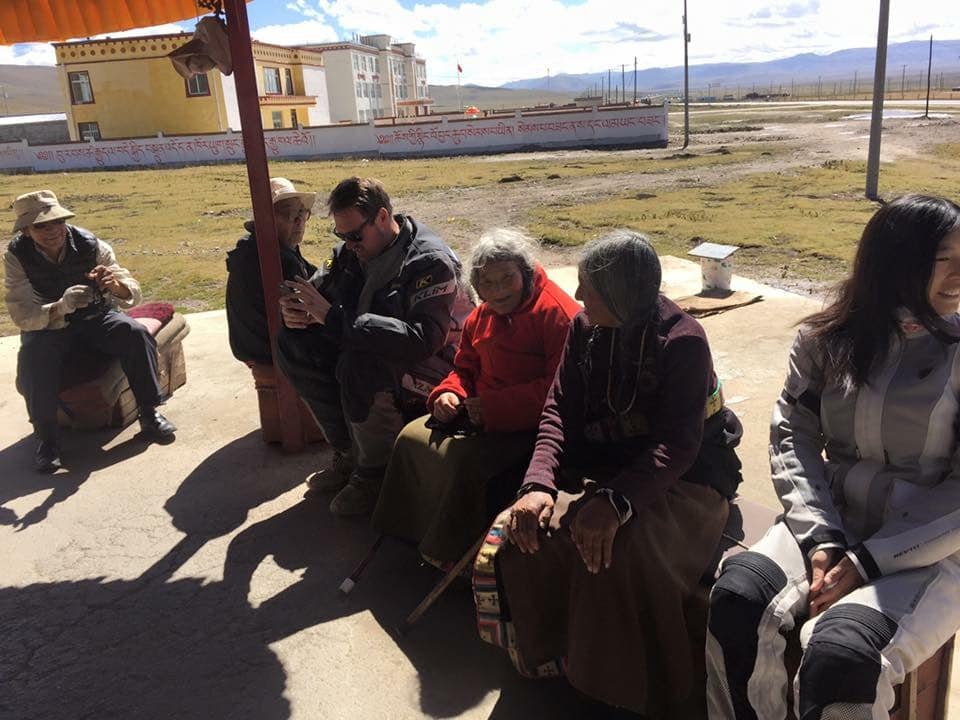
Back on the road, it was a challenge not to stop every few hundred yards, as every view was like a postcard. The scenery was sometimes like the Alps and sometimes like the English countryside. There were large valleys such as you find between mountain ranges in the American west. We had lunch at a very cool restaurant called The Black Tent. It was full of western backpackers and monks. I had spaghetti!
After lunch, we hit 30 miles of road construction, but it was dry, so no mud. We had to deal with vehicle dust, but were able to proceed fairly quickly, and definitely prefer dust to mud!
Then something magical happened. We stumbled on the Waqie Monastery. We estimated at least 100 acres of prayer flags.
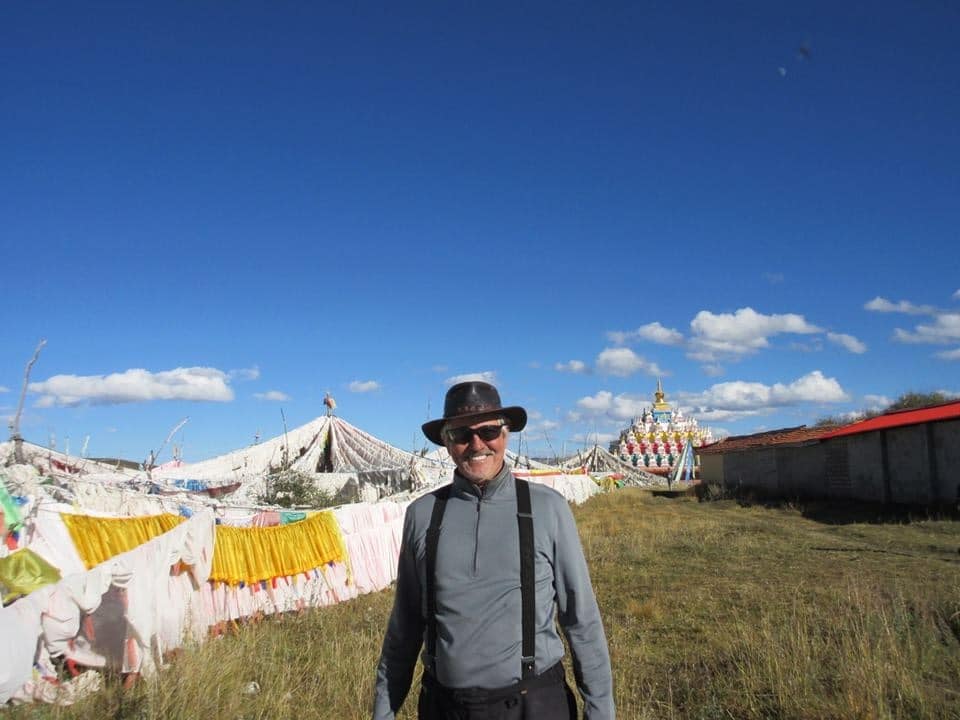 Several pagodas offered clockwise walking. Prayer wheels were plentiful, in one, two and three tiers. I am certain that most Chinese will never see anything like this, and certainly no Americans. We are so lucky to have spent the last few days in the real, rural China. I hated for the day to end. (by Randy MacClanahan)
Several pagodas offered clockwise walking. Prayer wheels were plentiful, in one, two and three tiers. I am certain that most Chinese will never see anything like this, and certainly no Americans. We are so lucky to have spent the last few days in the real, rural China. I hated for the day to end. (by Randy MacClanahan)
This afternoon, after a whole lot of dirt road motorcycle riding, we came upon a Buddhist monastery in the middle of nowhere, Tibetan China. (by David Fick)
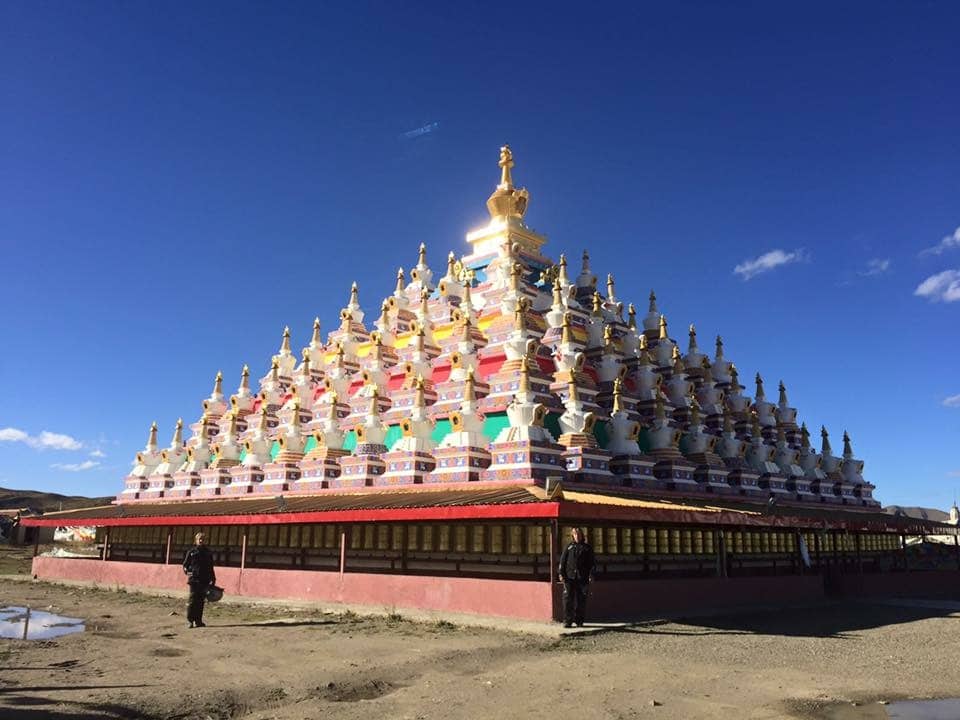 We are on a high plateau, in an area mostly populated by yaks and sheep. From a distance we could see hundreds of thousands, probably millions, of prayer flags spread over at least 100 acres, with prayer structures throughout.
We are on a high plateau, in an area mostly populated by yaks and sheep. From a distance we could see hundreds of thousands, probably millions, of prayer flags spread over at least 100 acres, with prayer structures throughout.
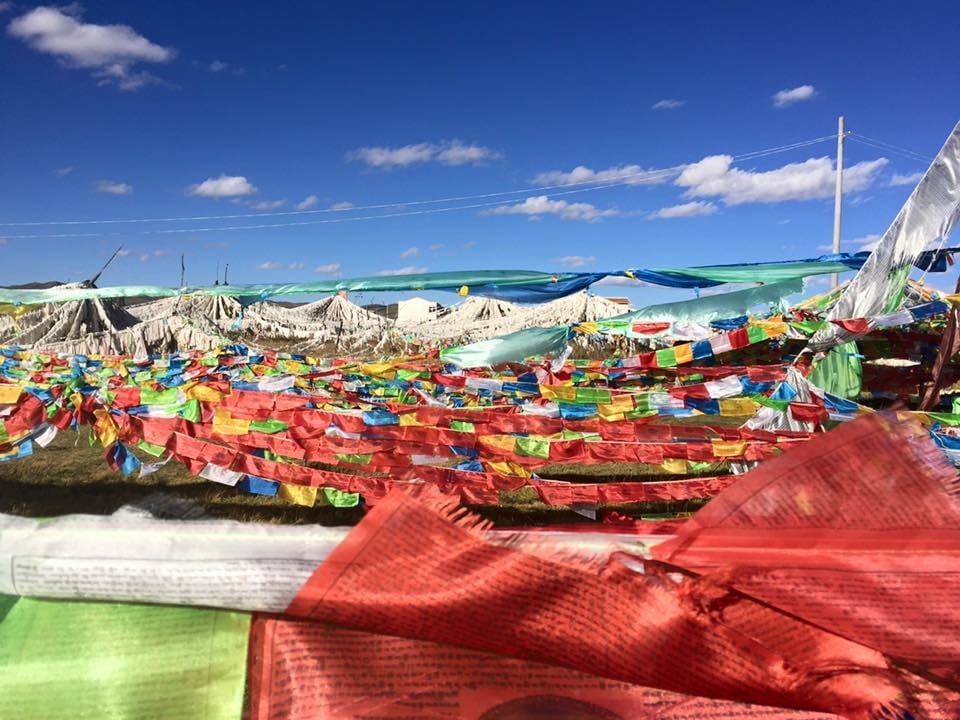
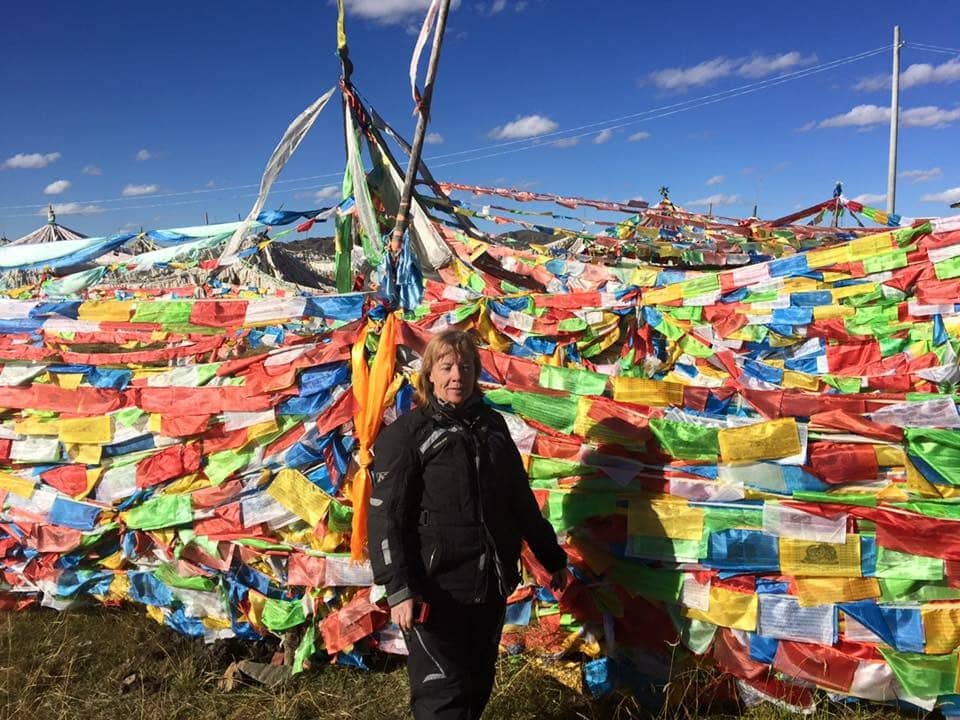 We spun some prayer drums and walked around in amazement. Pictures don’t do justice.
We spun some prayer drums and walked around in amazement. Pictures don’t do justice.
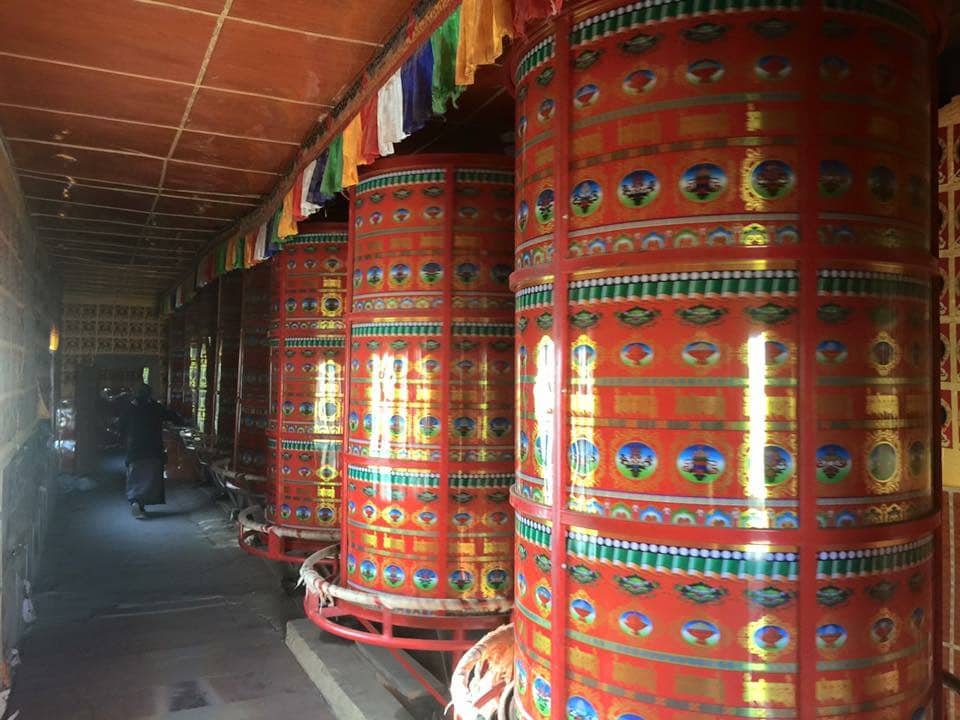
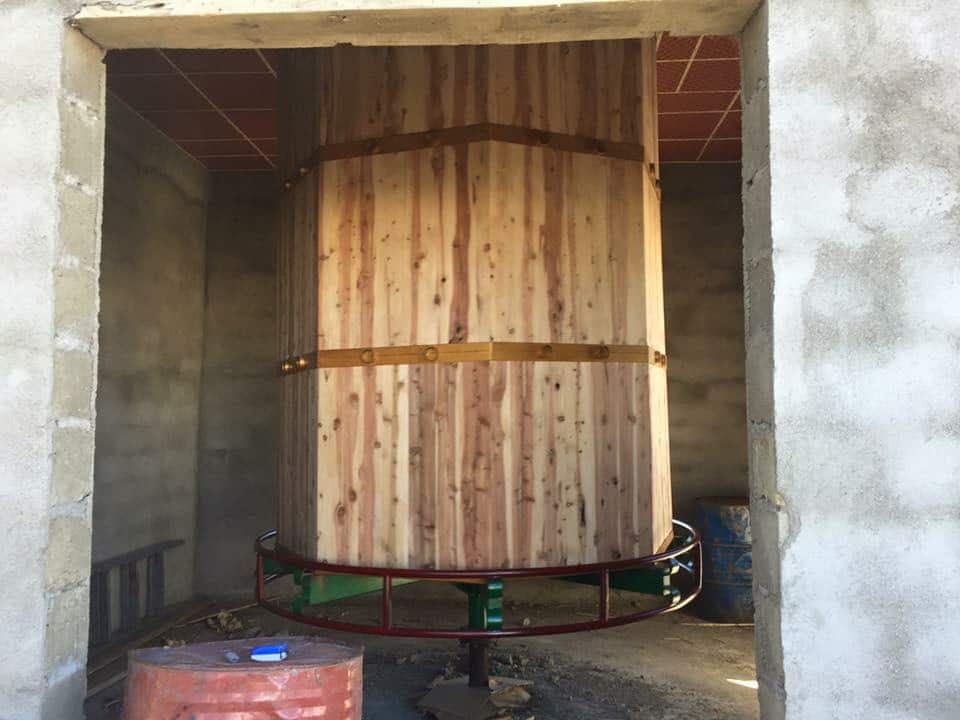
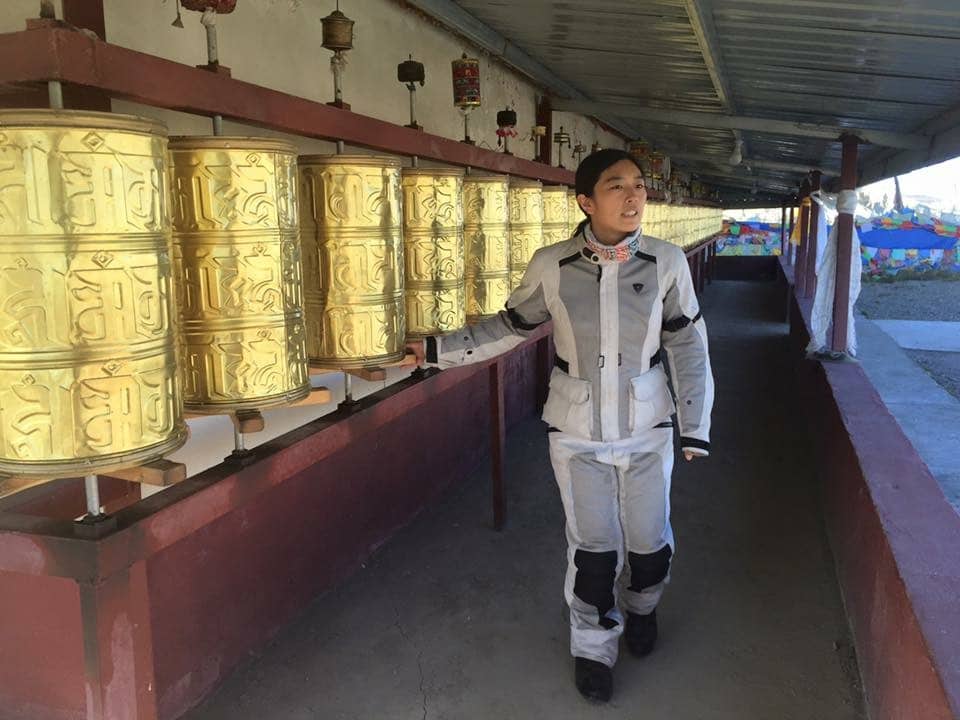 Out of respect for the worshippers we didn’t take any pictures of the big drums being spun endlessly inside one of the buildings. We don’t know what it means, but it is serious business here.
Out of respect for the worshippers we didn’t take any pictures of the big drums being spun endlessly inside one of the buildings. We don’t know what it means, but it is serious business here.
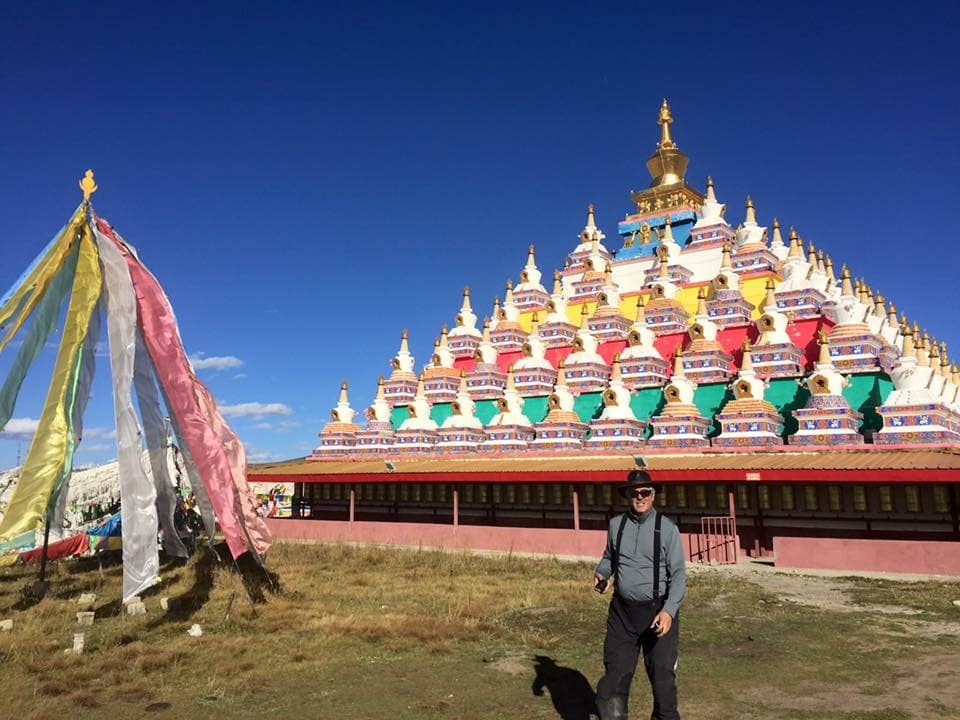
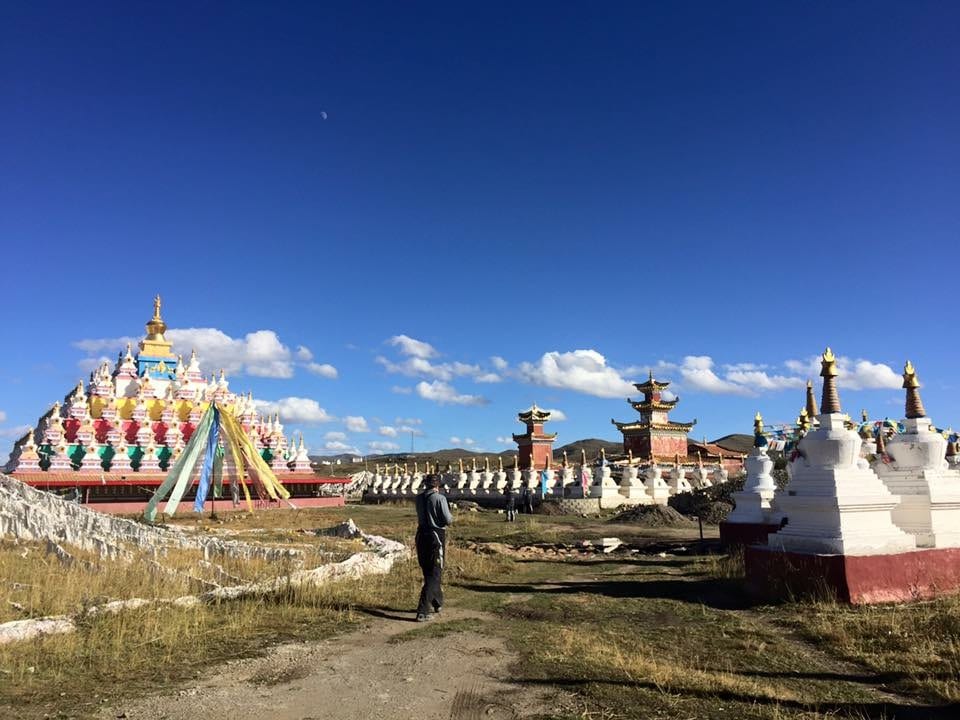
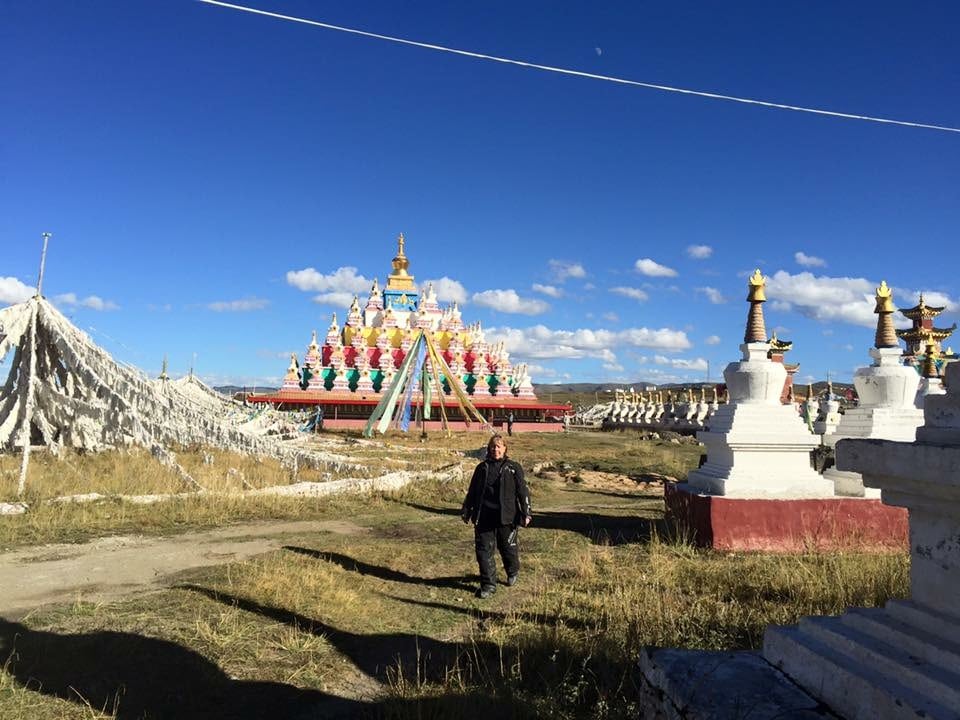
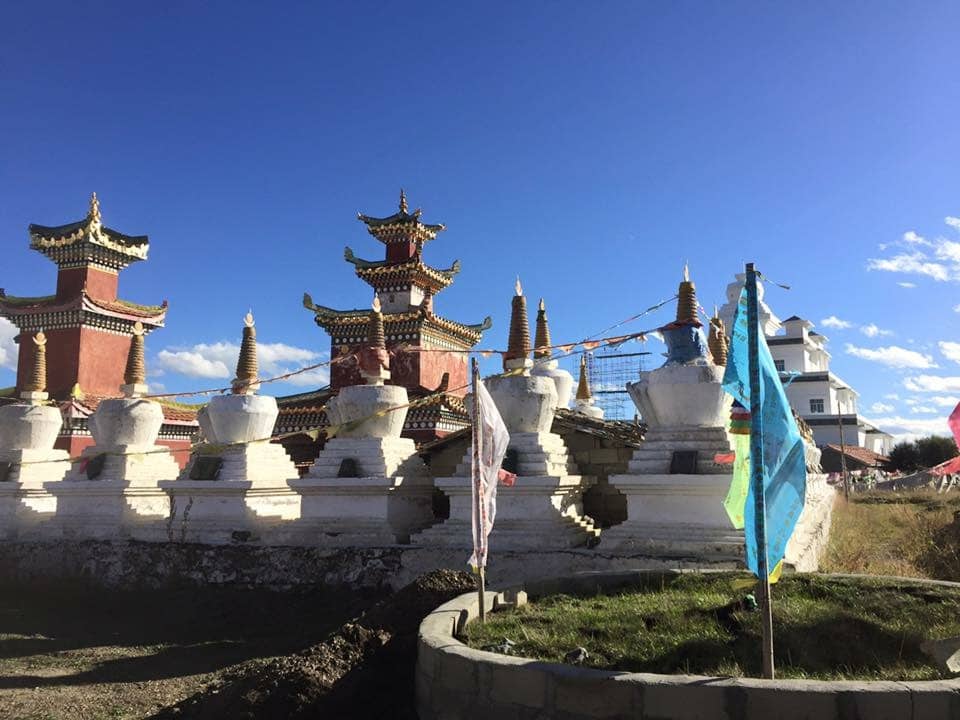 Tomorrow we will ride down from the Tibetan mountains, into Sichaun province and its capital, Chengdu, home of the giant panda. (by David Fick)[/fusion_builder_column/]
Tomorrow we will ride down from the Tibetan mountains, into Sichaun province and its capital, Chengdu, home of the giant panda. (by David Fick)[/fusion_builder_column/]
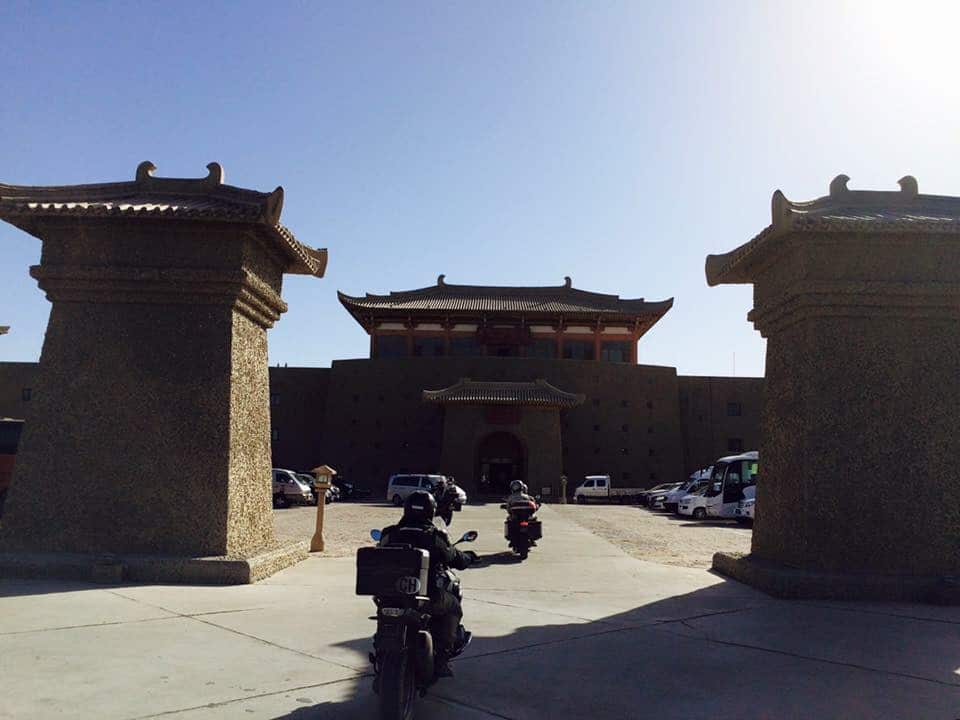
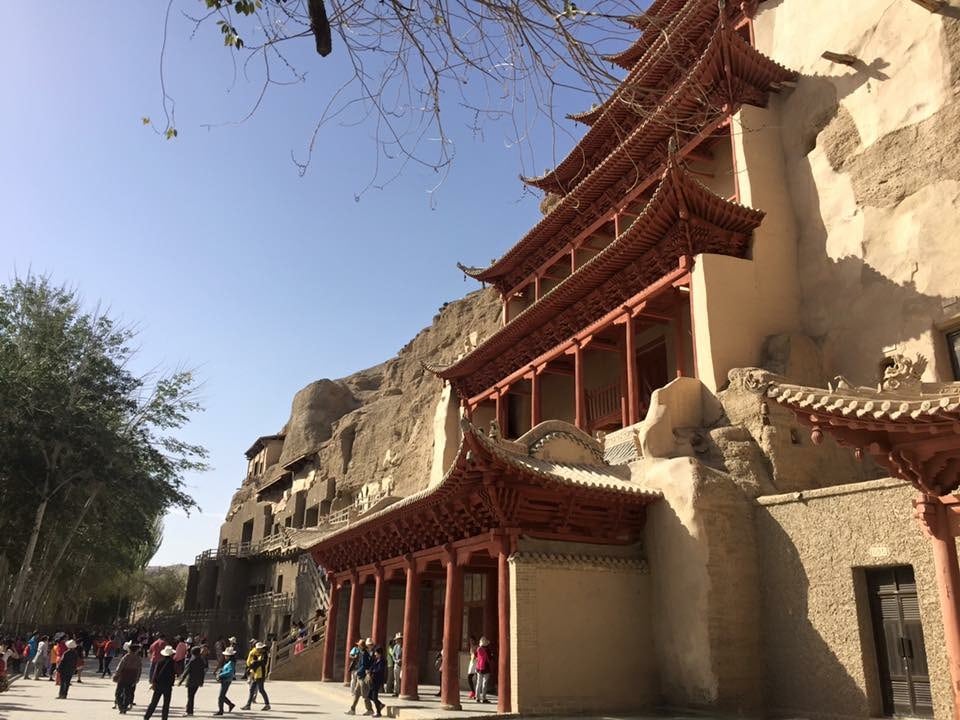
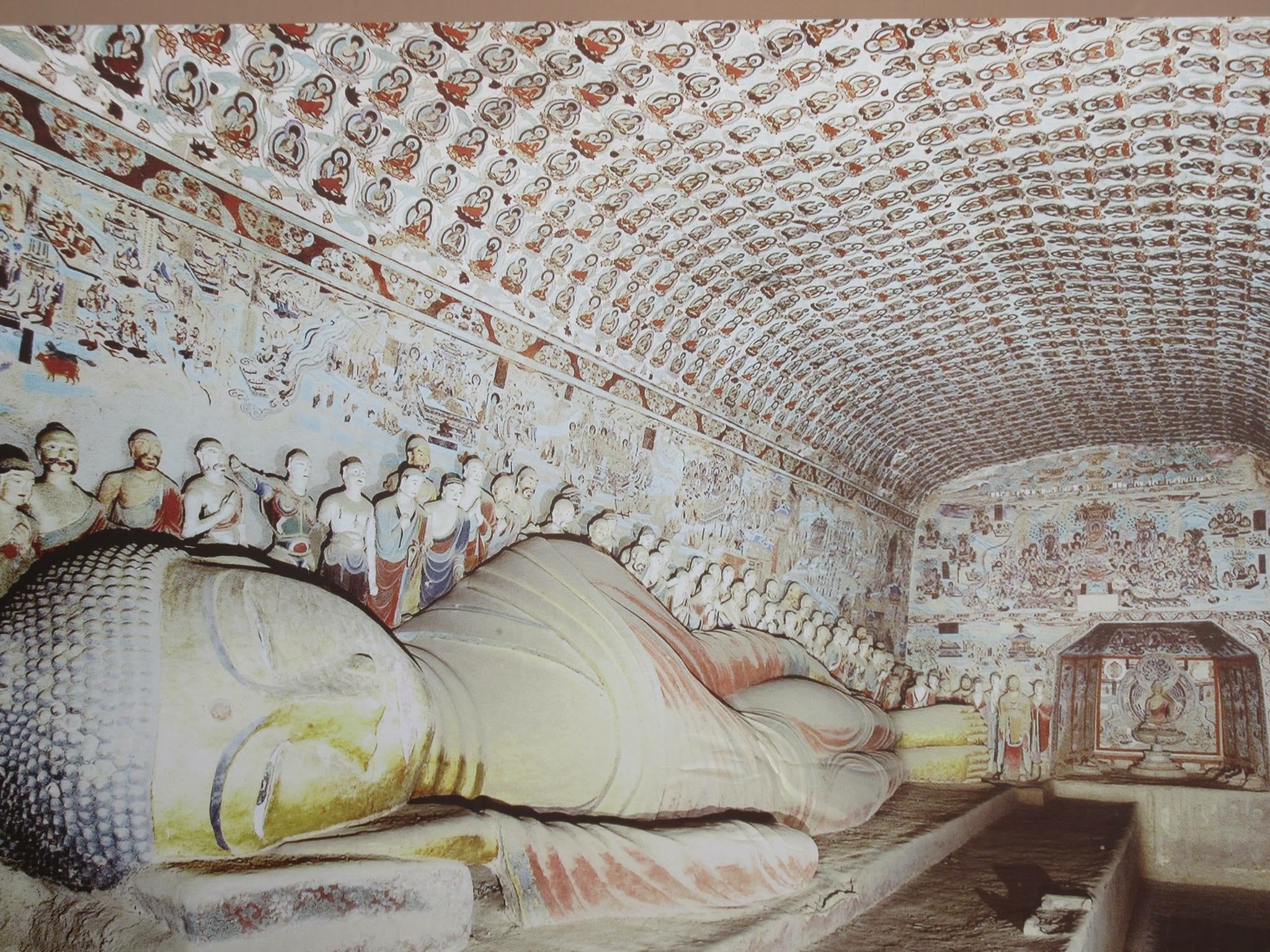
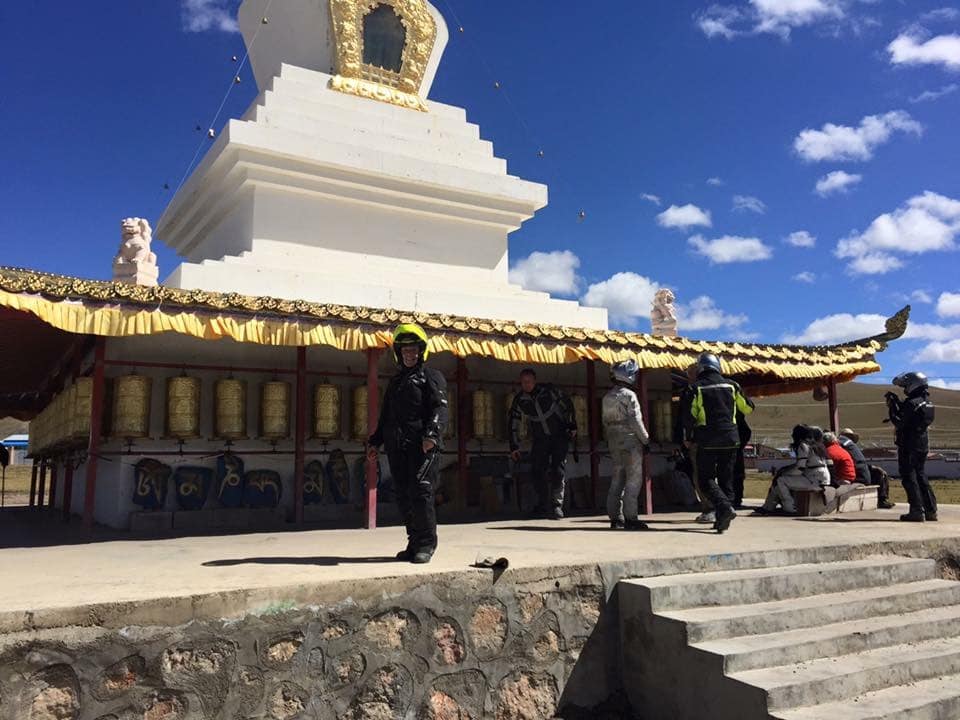
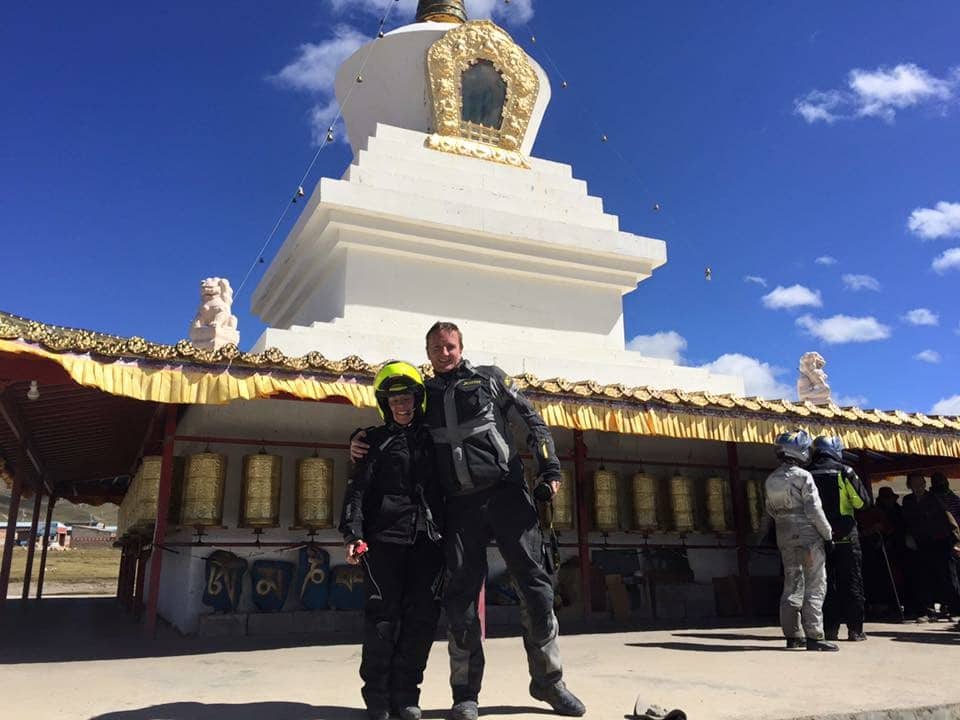
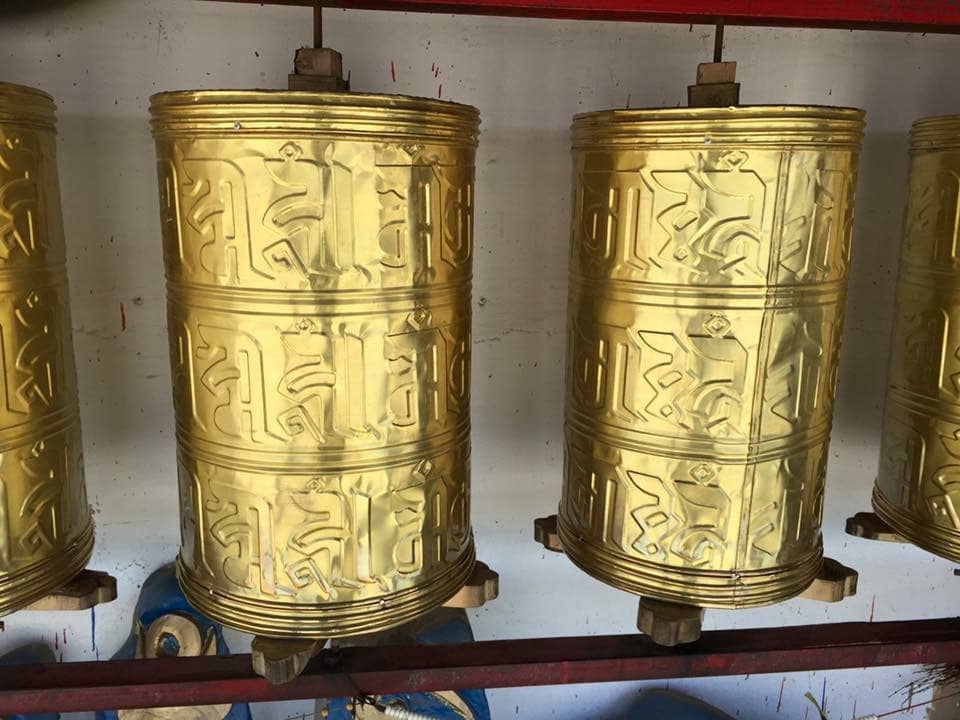
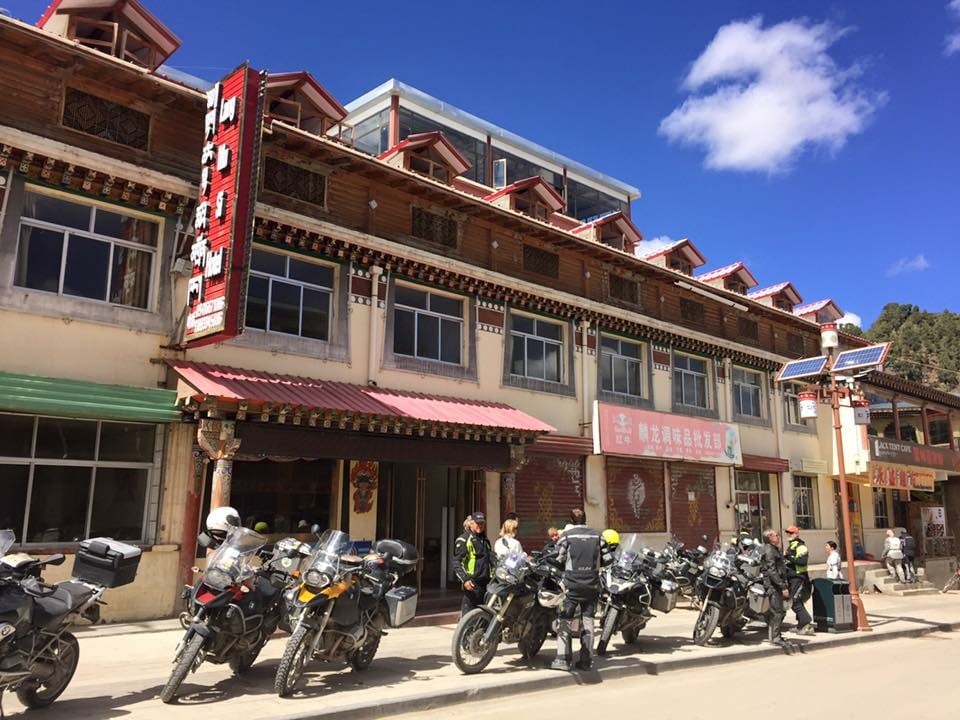
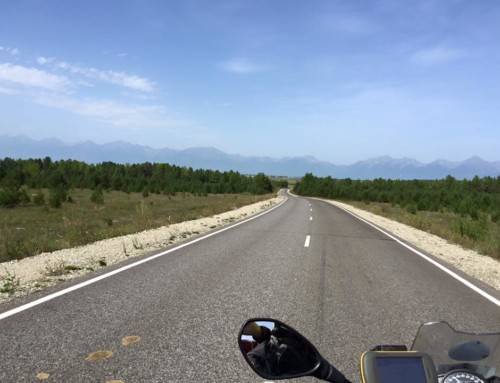
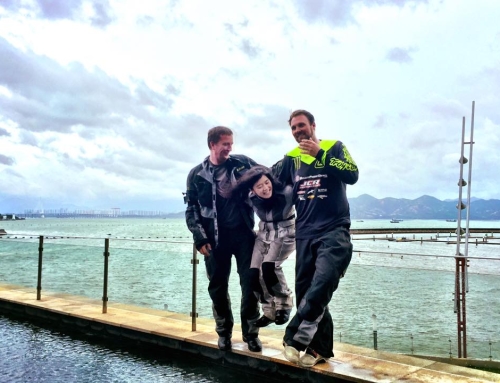
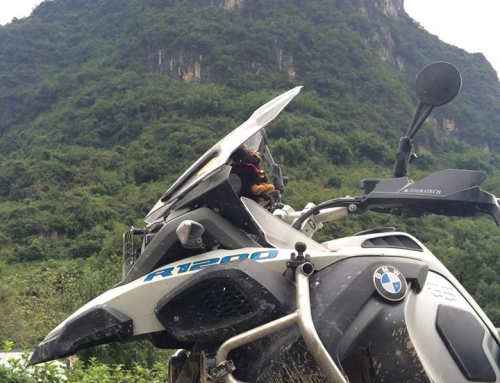
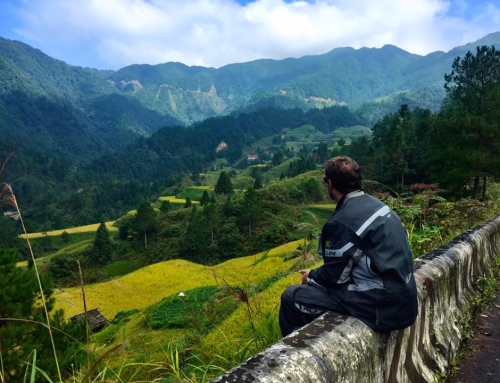
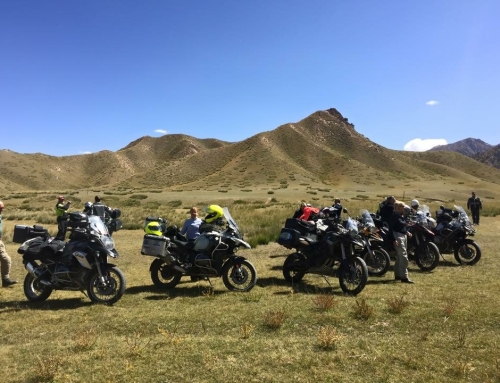
WOW I don’t want to see this “Epic Adventure” end. Look forward to reading your post at work, where I can escape from the reality of a job. Thanks, C